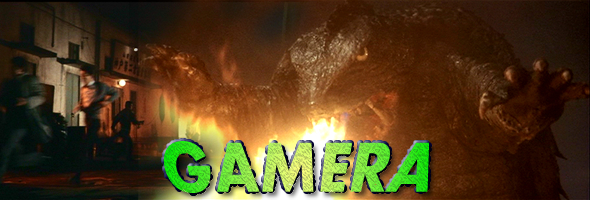
GAMERA: THE GIANT MONSTER
B&W, 1965, 78 mins. 35 secs. / 85 mins. 42 secs.
Directed by Noriaki Yuasa
Starring Eiji Funakoshi, Harumi Kiritachi, Junichirô Yamashita
Arrow Video (Blu-ray) (US/UK RA HD), Mill Creek (Blu-ray) (US RA HD), Shout Factory (US R1 NTSC), Daiei (Japan R2 NTSC) / WS (2.35:1) (16:9)
GAMERA VS. BARUGON
Color, 1966, 100 mins. 15 secs. / 88 mins. 45 secs.
Starring Kojiro Hongo, Kyoko Enami
Arrow Video (Blu-ray) (US/UK RA HD), Mill Creek (Blu-ray) (US RA HD), Shout Factory (US R1 NTSC), Daiei (Japan R2 NTSC) / WS (2.35:1) (16:9)
GAMERA VS. GYAOS
Color, 1967, 86 mins. 26 secs.
Directed by Noriaki Yuasa
Starring Kojiro Hongo, Kichijiro Ueda, Naoyuki Abe
GAMERA VS. VIRAS
Color, 1968, 72 mins. 14 secs. / 81 mins. 17 secs. / 90 mins. 24 secs.
Directed by Noriaki Yuasa
Starring Kojiro Hongo, Toru Takatsuka, Carl Craig Jr.
Arrow Video (Blu-ray) (US/UK RA HD), Mill Creek (Blu-ray) (US RA HD), Shout Factory (US R1 NTSC), Daiei (Japan R2 NTSC) / WS (2.35:1) (16:9)
GAMERA VS. GUIRON
Color, 1969, 82 mins. 10 secs.
Directed by Noriaki Yuasa
Starring Nobuhiro Kajima, Miyuki Akiyama, Chrystopher Murphy, Yuko Hamada
Arrow Video (Blu-ray) (US/UK RA HD), Mill Creek (Blu-ray) (US RA HD), Shout Factory (US R1 NTSC), Daiei (Japan R2 NTSC) / WS (2.35:1) (16:9)
GAMERA VS. JIGER
Color, 1970, 82 mins. 46 secs.
Directed by Noriaki Yuasa
Starring Tsutomu Takakuwa, Kelly Varis, Katherine Murphy, Kon Omura
Arrow Video (Blu-ray) (US/UK RA HD), Mill Creek (Blu-ray) (US RA HD), Shout Factory (US R1 NTSC), Daiei (Japan R2 NTSC) / WS (2.35:1) (16:9)
GAMERA VS. ZIGRA
Color, 1971, 88 mins. 14 secs.
Directed by Noriaki Yuasa
Starring Kôji Fujiyama, Daigo Inoue, Reiko Kasahara
Arrow Video (Blu-ray) (US/UK RA HD), Mill Creek (Blu-ray) (US RA HD), Shout Factory (US R1 NTSC), Daiei (Japan R2 NTSC) / WS (2.35:1) (16:9)
GAMERA: SUPER MONSTER
Color, 1980, 91 mins. 57 secs.
Directed by Noriaki Yuasa
Starring Mach Fumiake, Yaeko Kojima, Yoko Komatsu
Arrow Video (Blu-ray) (US/UK RA HD), Mill Creek (Blu-ray) (US RA HD), Shout Factory (US R1 NTSC), Daiei (Japan R2 NTSC) / WS (1.85:1) (16:9)
GAMERA: GUARDIAN OF THE UNIVERSE
Color, 1995, 95 mins. 30 secs.
Directed by Shûsuke Kaneko
Starring Ayako Fujitani, Tsuyoshi Ihara, Akira Onodera, Shinobu Nakayama, Keiko Kudo
Arrow Video (Blu-ray) (US/UK RA HD), Mill Creek (Blu-ray) (US RA HD), Daiei (Japan R2 NTSC) / WS (2.35:1) (16:9)
GAMERA 2: ATTACK OF LEGION
Color, 1996, 99 mins. 42 secs.
Directed by Shûsuke Kaneko
Starring Toshiyuki Nagashima, Miki Mizuno, Tamotsu Ishibashi
Arrow Video (Blu-ray) (US/UK RA HD), Mill Creek (Blu-ray) (US RA HD), Daiei (Japan R2 NTSC) / WS (2.35:1) (16:9)
GAMERA 3: REVENGE OF IRIS
Color, 1999, 107 mins. 48 secs.
Directed by Shûsuke Kaneko
Starring Shinobu Nakayama, Ai Maeda, Yukijirô Hotaru, Ai Mayeda
Arrow Video (Blu-ray) (US/UK RA HD), Mill Creek (Blu-ray) (US RA HD), Daiei (Japan R2 NTSC) / WS (2.35:1) (16:9)
GAMERA THE BRAVE
Color, 2006, 96 mins. 53 secs.
Directed by Ryuta Tasaki
Starring Ryô Tomioka, Kaho, Shingo Ishikawa
Arrow Video (Blu-ray) (US/UK RA HD), Mill Creek (Blu-ray) (US RA HD), Daiei (DVD) (Japan R2 NTSC), Tokyo Shock (DVD) (US R1 NTSC) / WS (2.35:1) (16:9)
Among 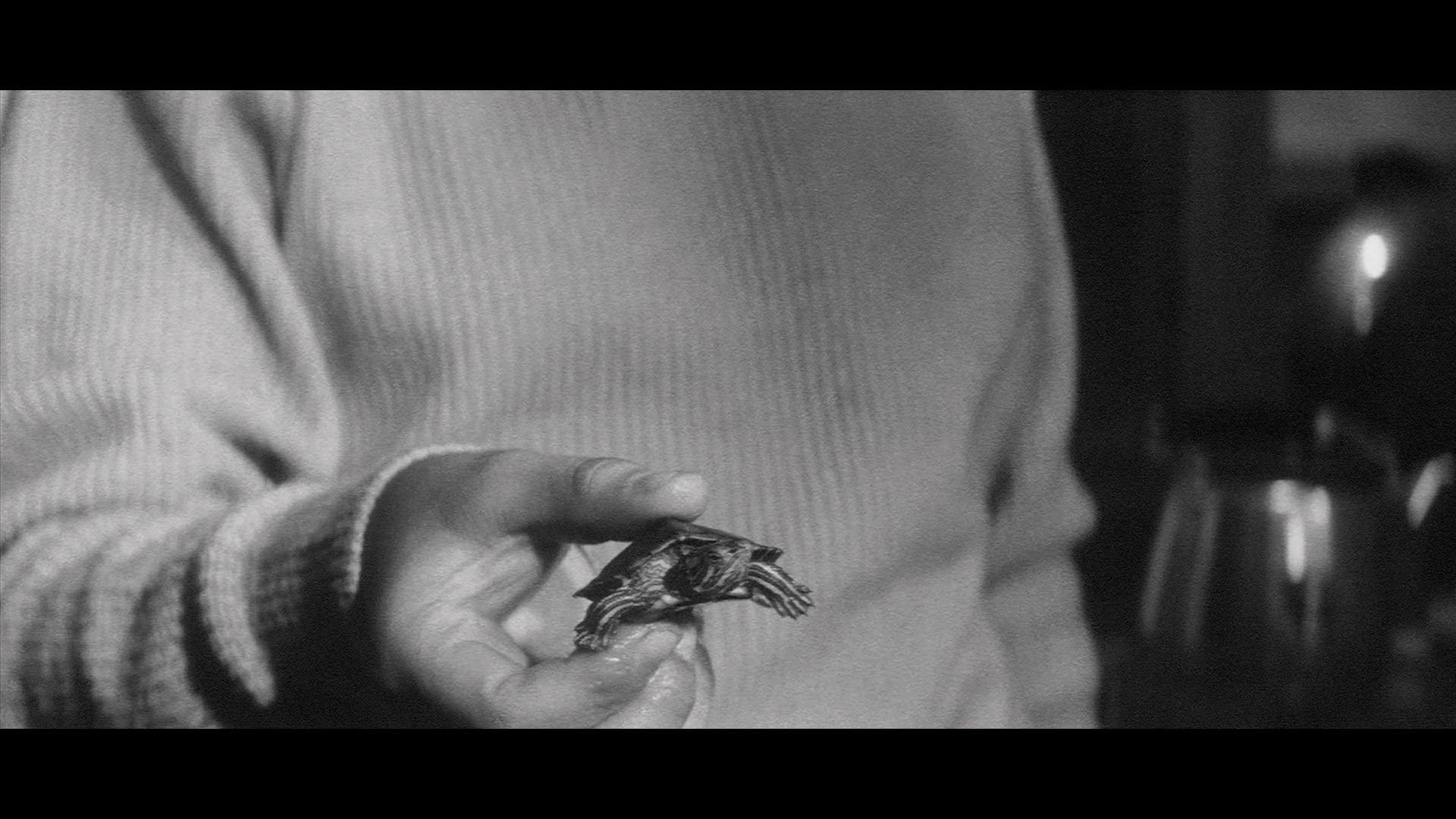 the numerous
the numerous 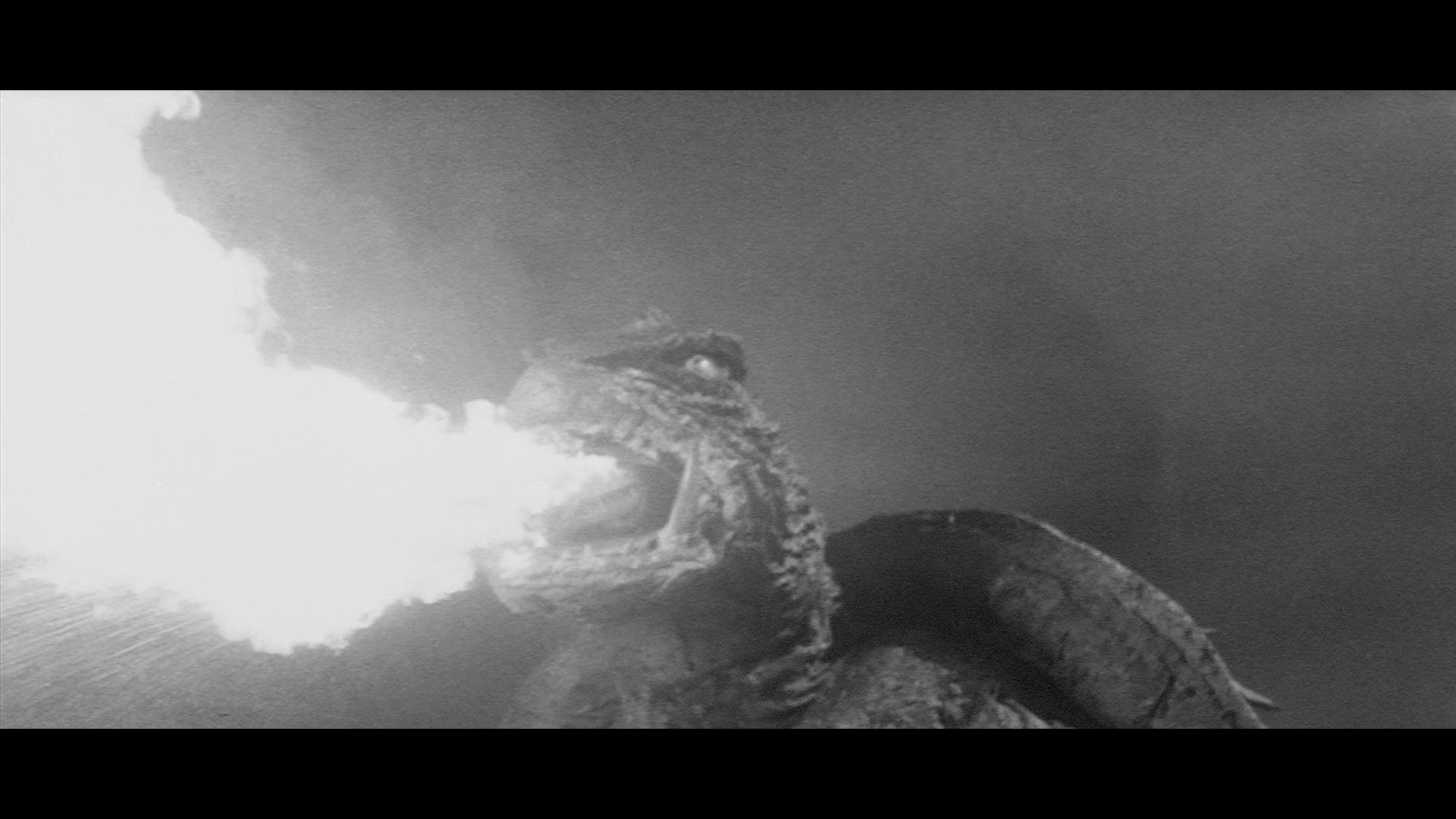 oversized beasts who terrorized Japan on screen in the '60s and '70s, Gamera is usually the one people think of right after a certain fire-breathing lizard. An enormous turtle capable of standing upright, roaring, spewing flame, flying in his spinning shell, and kicking lots of monster tail, Gamera first appeared as Daiei Motion Picture Company's competitor to Godzilla in the kaiju eiga sweepstakes with 1965's Daikaijű Gamera (Gamera: The Giant Monster), shown in America as Gammera the Invincible and Giant Monster Gamera. However, he didn't really achieve major English-language popularity until TV afternoon immortality turned him into a children's favorite. Gamera enjoyed an original eight-film run from 1965 to 1980, with a crackerjack late '90s revival bringing him into the CGI age with a few tweaks. Since then the series has gotten numerous standalone and double feature releases in various configurations, but the one to beat by a long shot came in 2020 with a massive deluxe set from Arrow Video presenting each film on Blu-ray with a wealth of special features, language options, and genuinely staggering deluxe packaging.
oversized beasts who terrorized Japan on screen in the '60s and '70s, Gamera is usually the one people think of right after a certain fire-breathing lizard. An enormous turtle capable of standing upright, roaring, spewing flame, flying in his spinning shell, and kicking lots of monster tail, Gamera first appeared as Daiei Motion Picture Company's competitor to Godzilla in the kaiju eiga sweepstakes with 1965's Daikaijű Gamera (Gamera: The Giant Monster), shown in America as Gammera the Invincible and Giant Monster Gamera. However, he didn't really achieve major English-language popularity until TV afternoon immortality turned him into a children's favorite. Gamera enjoyed an original eight-film run from 1965 to 1980, with a crackerjack late '90s revival bringing him into the CGI age with a few tweaks. Since then the series has gotten numerous standalone and double feature releases in various configurations, but the one to beat by a long shot came in 2020 with a massive deluxe set from Arrow Video presenting each film on Blu-ray with a wealth of special features, language options, and genuinely staggering deluxe packaging.
As with most imports in the '60s and '70s, the Gamera films were heavily cut and shown in dubbed form in most countries. The original classic, Gamera the Giant Monster, experienced a fate similar to the first Godzilla as it was heavily altered for American audiences, with new scenes shot and added featuring Brian Donlevy and Albert Dekker (not to mention a very catchy new theme song). This is the one beaten to death by countless public domain labels over the years, including a really terrible version from Alpha Video. Another, more traditional dubbed version was also prepared for home video (as part of the infamous Sandy Frank library) and turned up from Mystery Science Theater 3000 along with 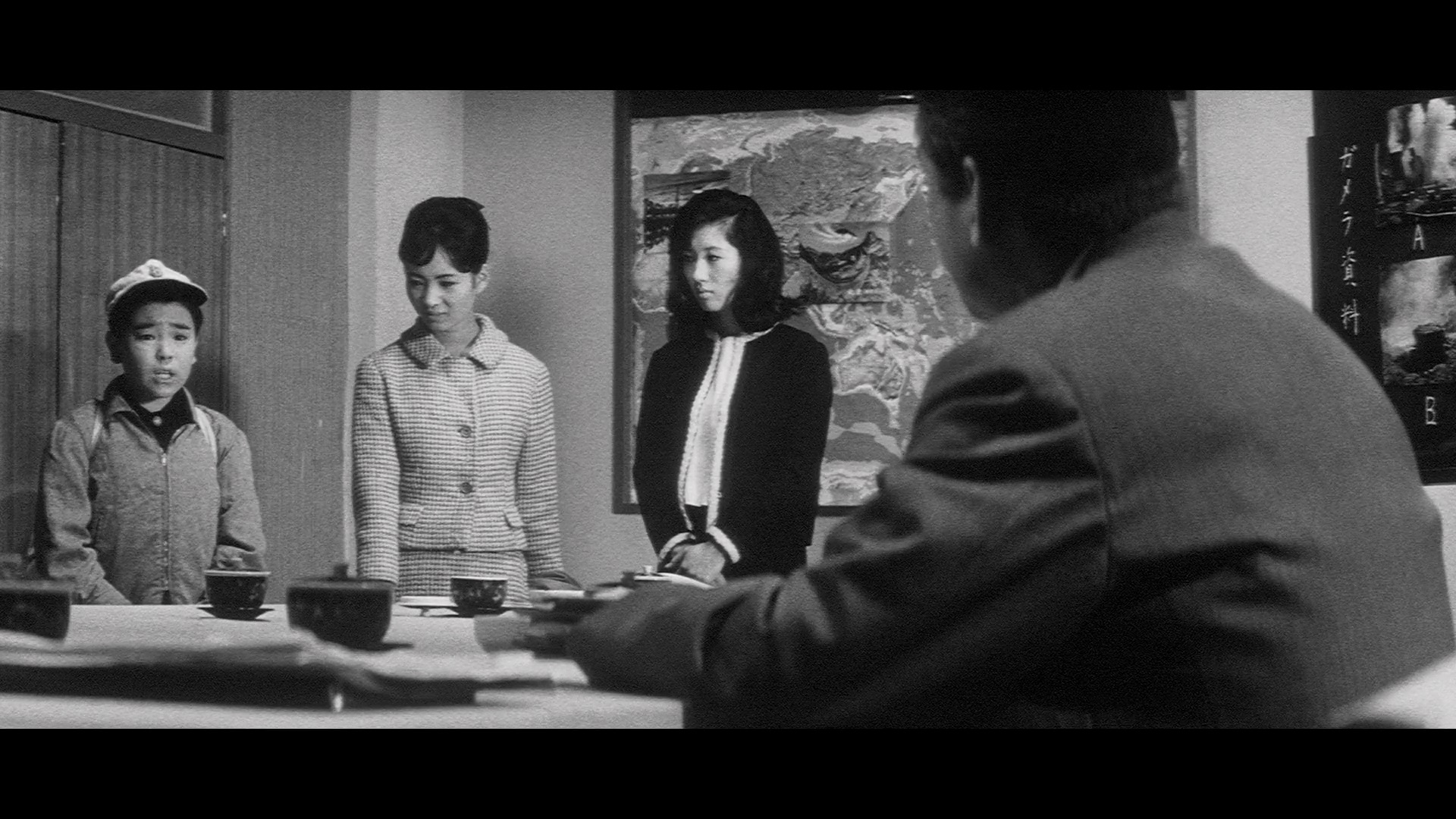 TV versions of other titles in the series. No matter how you see it, the plot is essentially the same; an atomic explosion awakens the
TV versions of other titles in the series. No matter how you see it, the plot is essentially the same; an atomic explosion awakens the 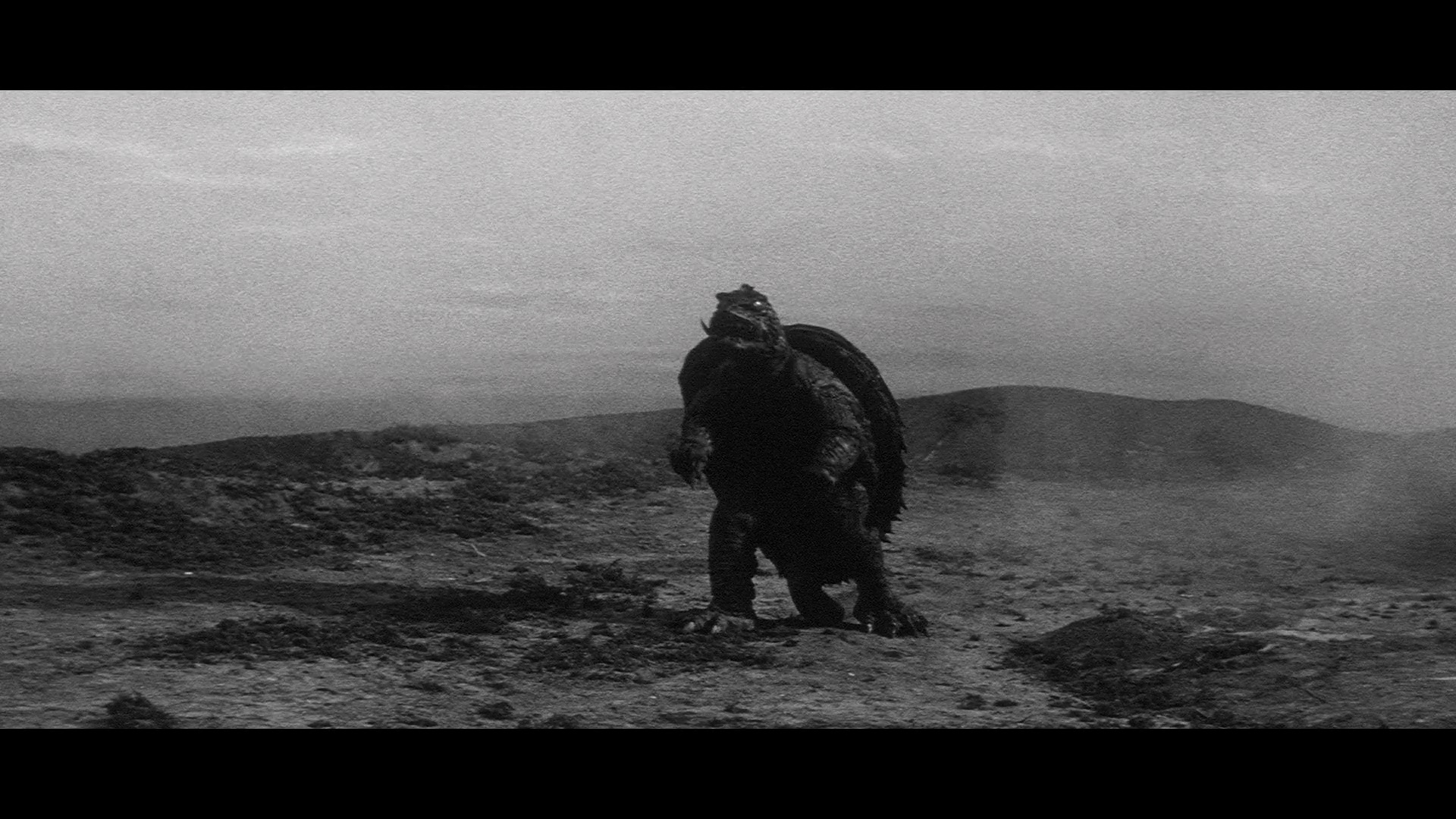 prehistoric Gamera from his sleep during a skirmish between American and Russian jets, and he soon makes his way to Tokyo while attacking a hapless ship in his path. Soon the entire city is under siege from the lumbering beast, and when his flying abilities stymie the military's attempts to crush him, scientists come up with a novel way of dealing with their big turtle problem. Fast-paced and entertaining, this is easily the most serious film in the serious as well as the only one shot in black and white. Perhaps the most startling element is the leading man, Dr. Hidaka, is played by Eiji Funakoshi, best known for much more traditional dramatic fare like Fires on the Plain, An Actor's Revenge, and a slew of Yasuzo Masumura films like Blind Beast and Manji; apparently he had a good time, since he returned to the series again a few years later.
prehistoric Gamera from his sleep during a skirmish between American and Russian jets, and he soon makes his way to Tokyo while attacking a hapless ship in his path. Soon the entire city is under siege from the lumbering beast, and when his flying abilities stymie the military's attempts to crush him, scientists come up with a novel way of dealing with their big turtle problem. Fast-paced and entertaining, this is easily the most serious film in the serious as well as the only one shot in black and white. Perhaps the most startling element is the leading man, Dr. Hidaka, is played by Eiji Funakoshi, best known for much more traditional dramatic fare like Fires on the Plain, An Actor's Revenge, and a slew of Yasuzo Masumura films like Blind Beast and Manji; apparently he had a good time, since he returned to the series again a few years later.
This film and its successors have all been released on Blu-ray before, most notably in 2014 as a fine but essentially skimpy set with all 11 films (but the first 8 featuring none of the beloved English dubs). It's also been around in its modified U.S. version due to its once-presumed PD status from a variety of DVD labels, with the best option before this being a Shout! Factory DVD of the Japanese cut that looked quite nice and featured an excellent commentary with Japanese monster historian August Ragone (who seems to know everything possible about this film), plus an enjoyable subtitled retrospective featurette (23m13s) with some of the original crew including director Yuasa. The Arrow Blu-ray carries over the Ragone commentary and features the original Japanese cut with either Japanese or English 1.0 LPCM mono options with English subtitles. Ragone also provides a new B&W video intro (13m12s) that makes for a fine intro if you haven't seen this before as well as some useful trivia about how this ties in with other Japanese films preceding it.  The modified
The modified  U.S. Gammera the Invincible edition is also here in the extras in all its scope glory, looking quite solid, with optional English subtitles plus the U.S. trailer and - joy! - a transfer of the original 45 single for that theme song by The Moons in both its vocal and instrumental arrangements. Play it back to back with The Green Slime for the full effect. The retrospective featurette is ported over here, plus a video interview with director Noriaki Yuasa (13m11s) shot by none other than Jorg Buttgereit at Daiei in front of a Daimajin statute in 2002, the alternate U.S. syndicated TV credits, the Japanese trailer, a U.S. video promo, and a huge image gallery (12m50s).
U.S. Gammera the Invincible edition is also here in the extras in all its scope glory, looking quite solid, with optional English subtitles plus the U.S. trailer and - joy! - a transfer of the original 45 single for that theme song by The Moons in both its vocal and instrumental arrangements. Play it back to back with The Green Slime for the full effect. The retrospective featurette is ported over here, plus a video interview with director Noriaki Yuasa (13m11s) shot by none other than Jorg Buttgereit at Daiei in front of a Daimajin statute in 2002, the alternate U.S. syndicated TV credits, the Japanese trailer, a U.S. video promo, and a huge image gallery (12m50s).
While the original Gamera was considerably more upbeat than the stark and grim first Gojira, the series darkened a bit (literally and figuratively) for its second and most serious entry, Gamera vs. Barugon, which was released a scant six months later. Like all the following films, this one ended up being shuffled off to American TV, this time under the title War of the Monsters in heavily edited form. The opening finds Gamera freed from his cosmic prison after being blasted into space, but much of the plot follows the disastrous consequences when some thieves trying to steal a valuable South Pacific opal instead get their hands on the egg of Barugon, a deadly lizard monster with icy blast breath and wild rainbow beams. Sure enough, an infrared beam 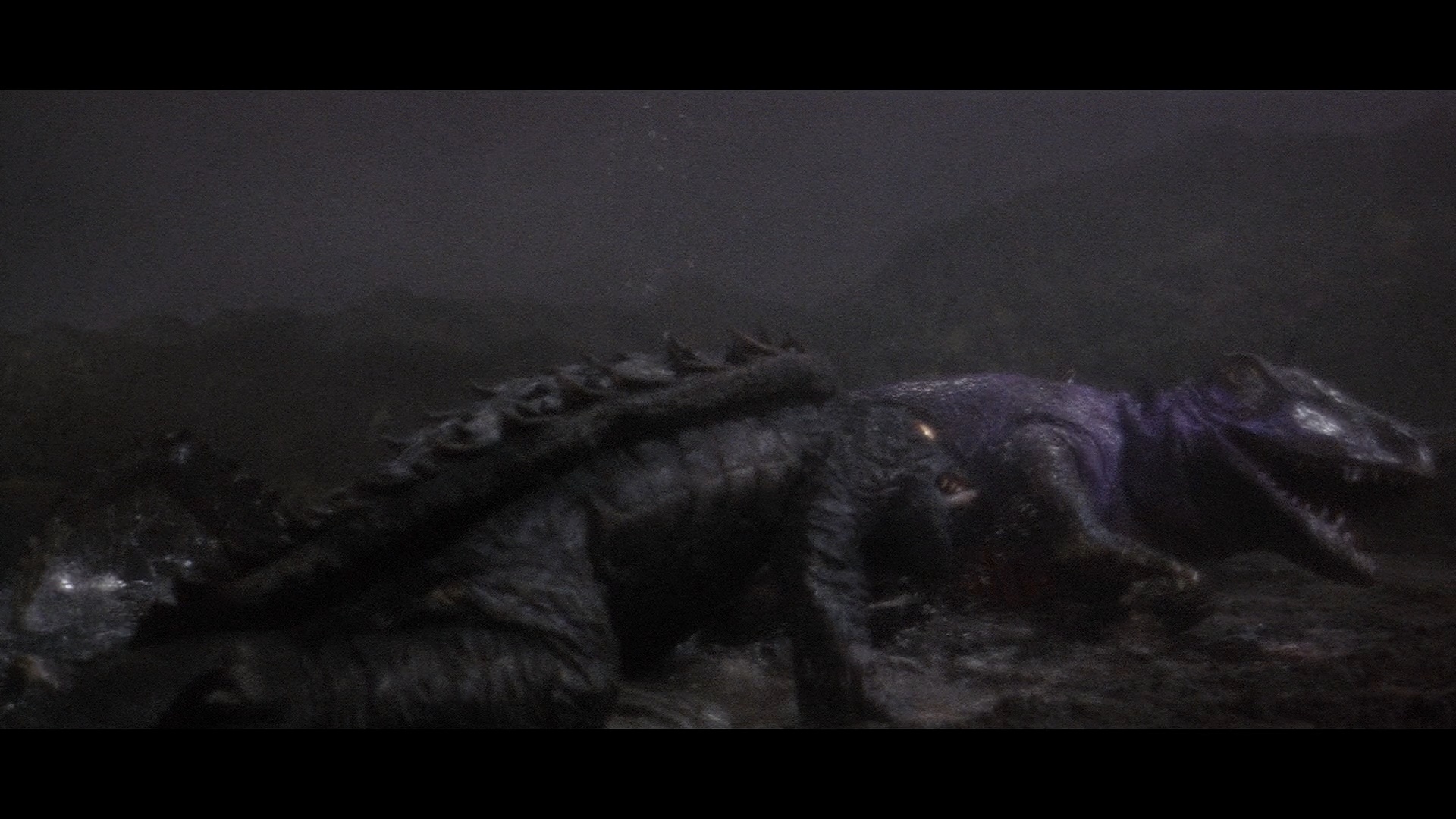 aboard the
aboard the 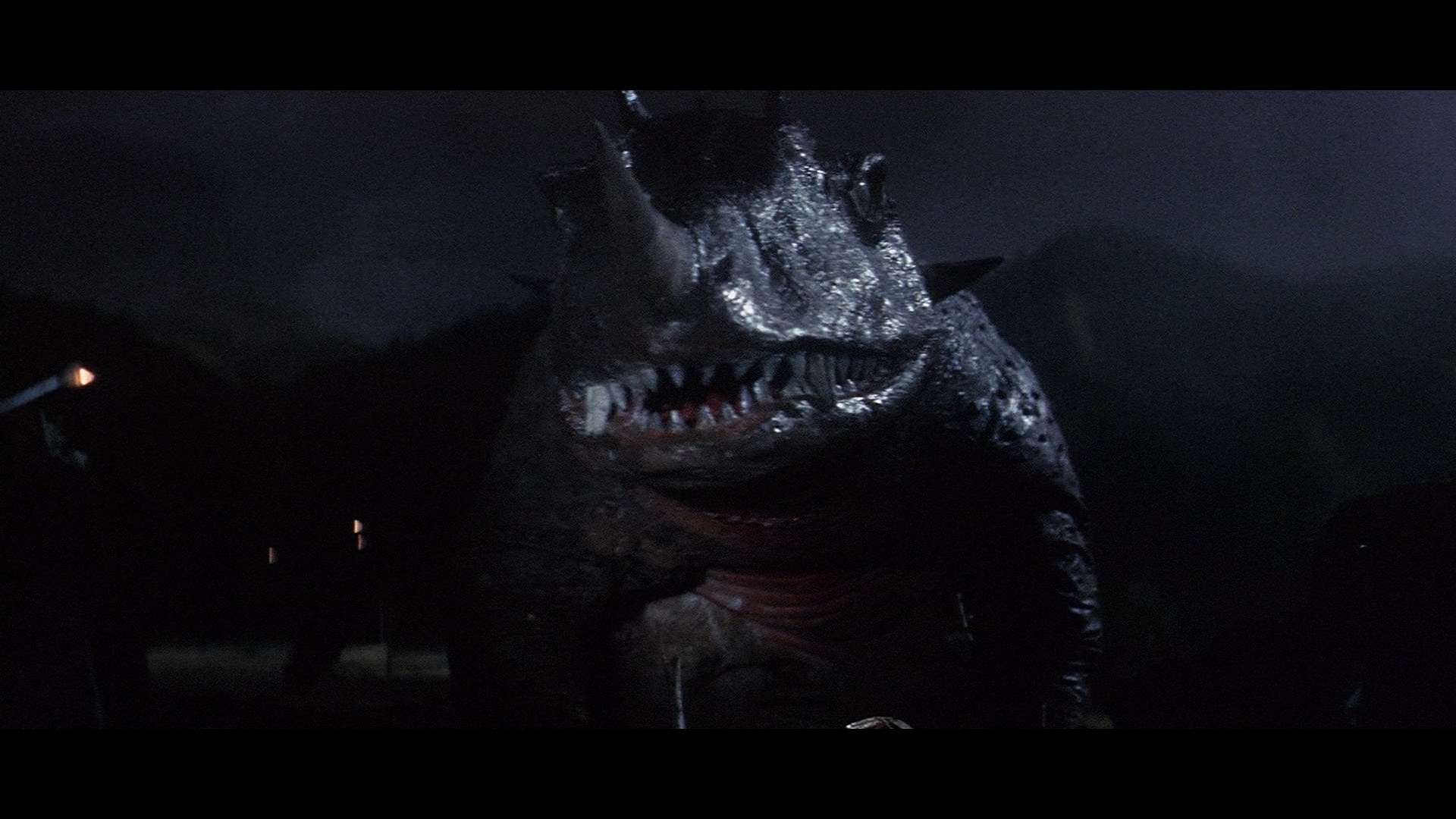 ship causes the egg to hatch, and a new terror is born. With Osaka under attack, the military comes up with an elaborate defense plan called the Infrared Diamond Lure and an exploitation of the monster's weakness to rain, but ultimately, only the returned Gamera may be its match.
ship causes the egg to hatch, and a new terror is born. With Osaka under attack, the military comes up with an elaborate defense plan called the Infrared Diamond Lure and an exploitation of the monster's weakness to rain, but ultimately, only the returned Gamera may be its match.
Wild, colorful, and entertaining, this film is easily one of the best in the series and would probably have a better reputation if more people had seen it uncut and in scope. The filmmaking here is vibrant and clever, and while the running time is definitely heftier than usual, the film features enough action and weird plot twists to keep fans occupied all the way. Again the Shout! Factory DVD was the first really respectable version with Ragone returning for another loaded commentary track, this time joined by Jason Varney as they rattle through the entire history of the film; it's not as interesting as the first film since the monster's genesis had already been covered, but it's a good shot given the protracted running time they had to fill. Also included were two galleries spotlighting poster and movie program art, as well as liner notes by actor Hongo and unique but awfully lengthy bios for all the film's major characters (along with the great anatomical diagram of Gamera which adorns each release, plus a bonus one for Barugon). The Arrow disc ups the ante by porting over the commentary track while adding a new Ragone intro (7m57s) while adding the full 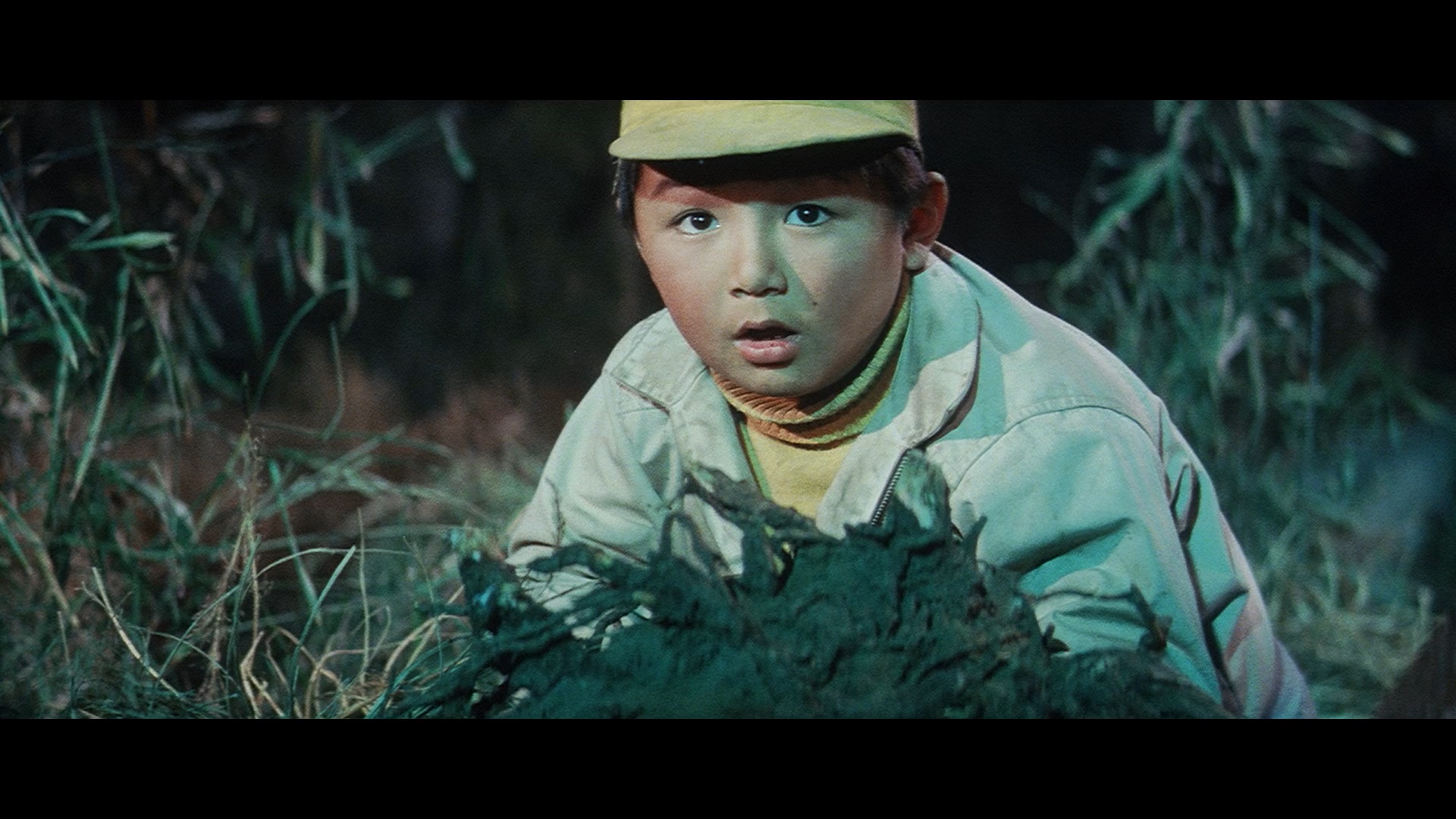 War of the
War of the 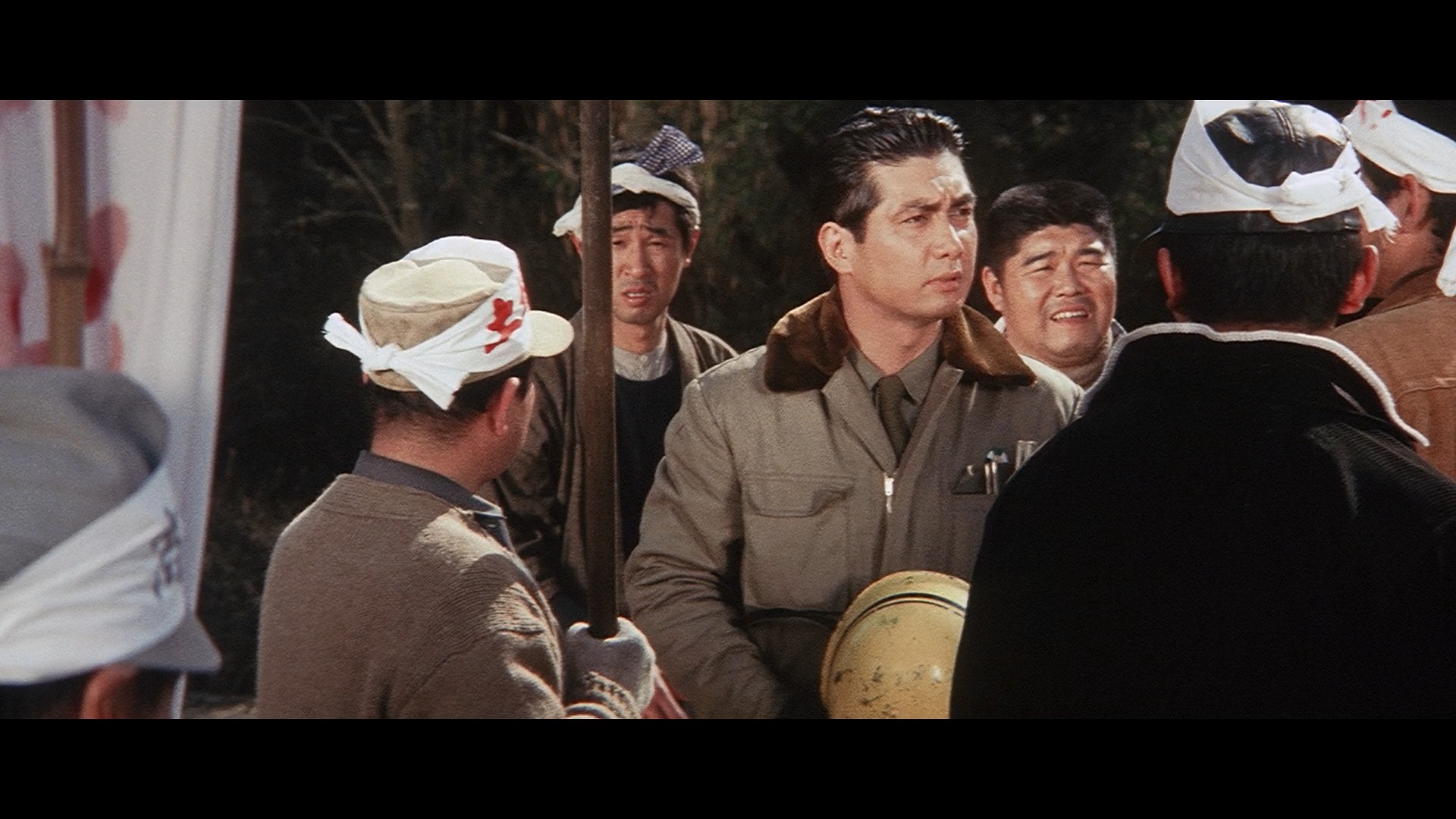 Monsters cut from AIP (looking great here in scope and comparable to the nice transfer of the main Japanese version with only a bit of emulsion damage at the very end), three Japanese trailers, two alternate main titles from the AIP and Sandy Frank versions, and another massive image gallery (21m41s). The main Japanese version has a nice little perk with the addition of the A.I.T.V. and Daiei English dubs on top of the Japanese track, all LPCM 1.0, with optional English subs.
Monsters cut from AIP (looking great here in scope and comparable to the nice transfer of the main Japanese version with only a bit of emulsion damage at the very end), three Japanese trailers, two alternate main titles from the AIP and Sandy Frank versions, and another massive image gallery (21m41s). The main Japanese version has a nice little perk with the addition of the A.I.T.V. and Daiei English dubs on top of the Japanese track, all LPCM 1.0, with optional English subs.
After this film, the Gamera series took a hard left turn. Realizing that the lucrative children's market seemed to love the flying turtle the most (not to mention the prospect of selling the films off to TV in other territories), the films veered in a more juvenile direction in Gamera vs. Gyaos. Just as the Godzilla films began aiming more for the kiddies with fare like Son of Godzilla, here Gamera became "a friend to all children" on a much lower budget with plenty of recycled footage for good measure. Shown as Return of the Giant Monsters on American TV, this one begins with a highway construction dispute at Mount Fuji involving a small nearby village and the Express Engineering Corporation. 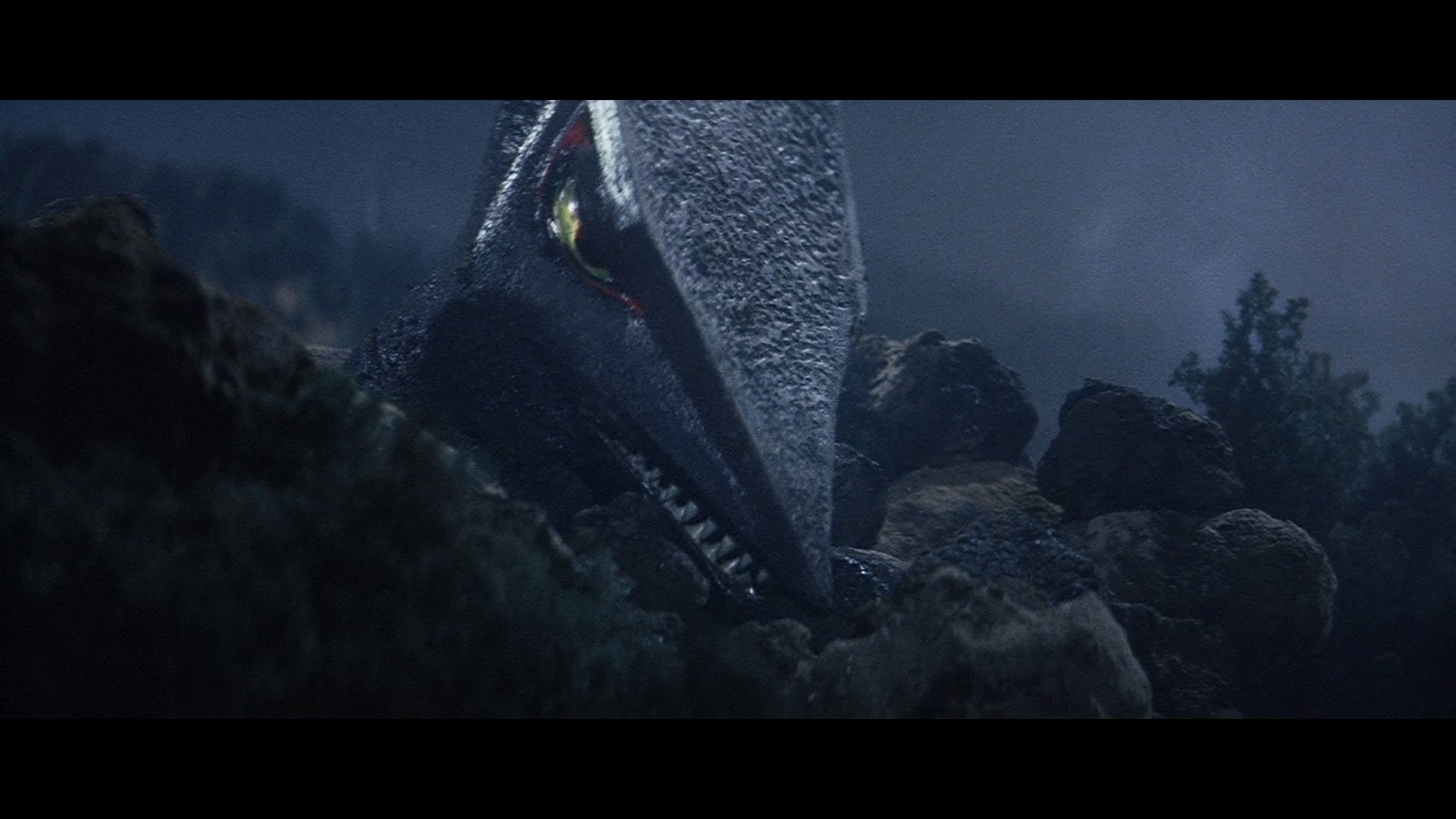 One
One 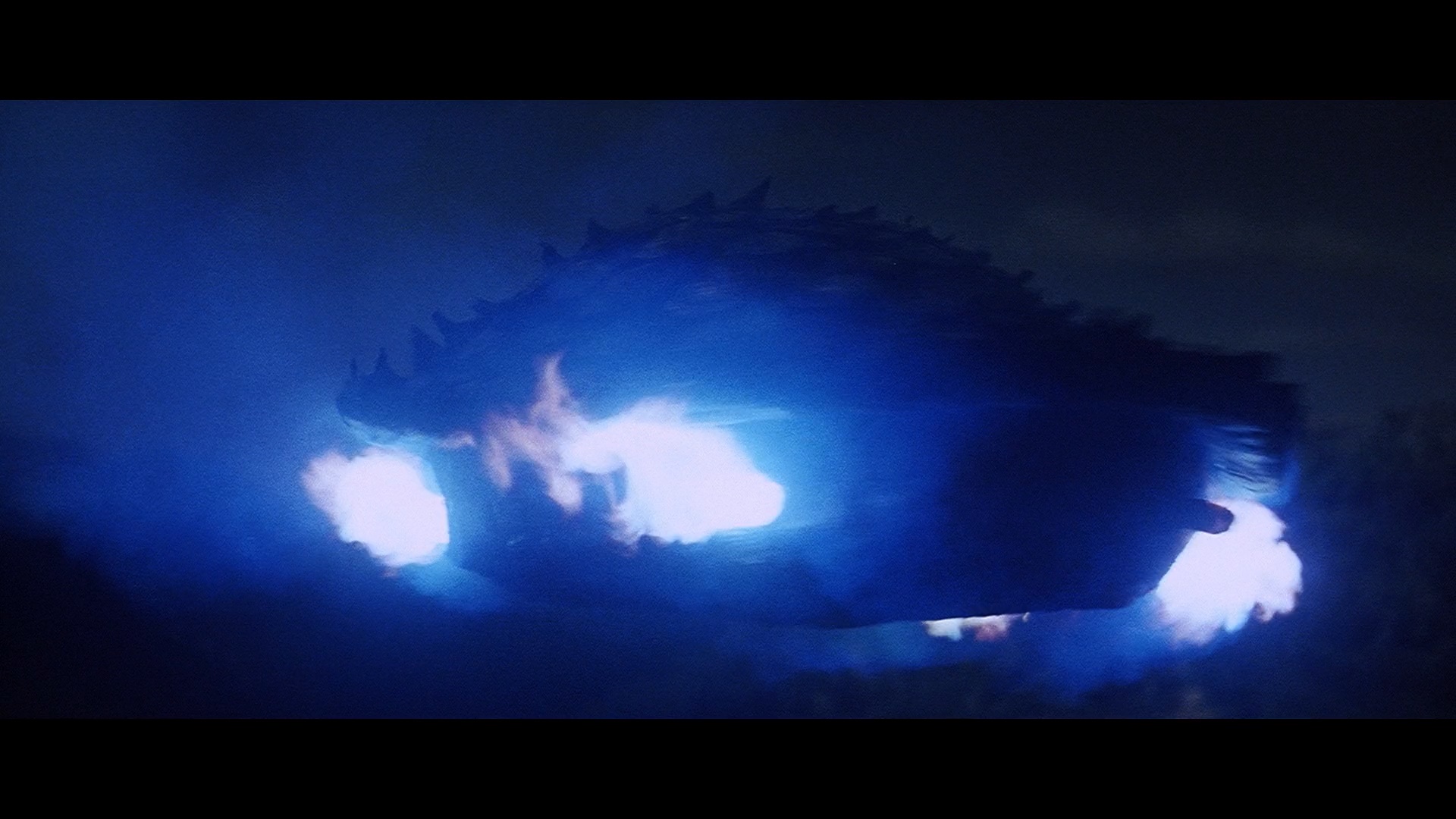 of the residents, cute kid Eiichi (Abe), becomes the focal character as chaos erupts with the emergence of a laser-shooting, cave-dwelling bat monster named Gyaos who nearly kills Eiichi, rescued in the nick of time by a nearby Gamera. Soon the monsters are going claw to claw in a fight to finish with Eiichi cheering his turtle friend on.
of the residents, cute kid Eiichi (Abe), becomes the focal character as chaos erupts with the emergence of a laser-shooting, cave-dwelling bat monster named Gyaos who nearly kills Eiichi, rescued in the nick of time by a nearby Gamera. Soon the monsters are going claw to claw in a fight to finish with Eiichi cheering his turtle friend on.
Actually quite good considering the change in game plan, Gyaos is a very trim, fun-filled ride if you don't mind the simplified tactics taken with the storyline. Gamera gets loads of screen time here, and Gyaos is a solid enough foe that he was resurrected to kick off the wonderful '90s reboot as well. Watch it in the right spirit, and you'll have a good time. The Arrow Blu-ray looks great again here and sports the Japanese mono track as well as the A.I.T.V. and Sandy Howard English subs, plus an audio commentary by Stuart Galbraith IV who provides a thorough historical analysis of the film's placement in the cycle and its connections to Japanese fantastic cinema of the era. As included are alternate English credits, Japanese and German trailers, a U.S. TV spot, a U.S. video promo, and an image 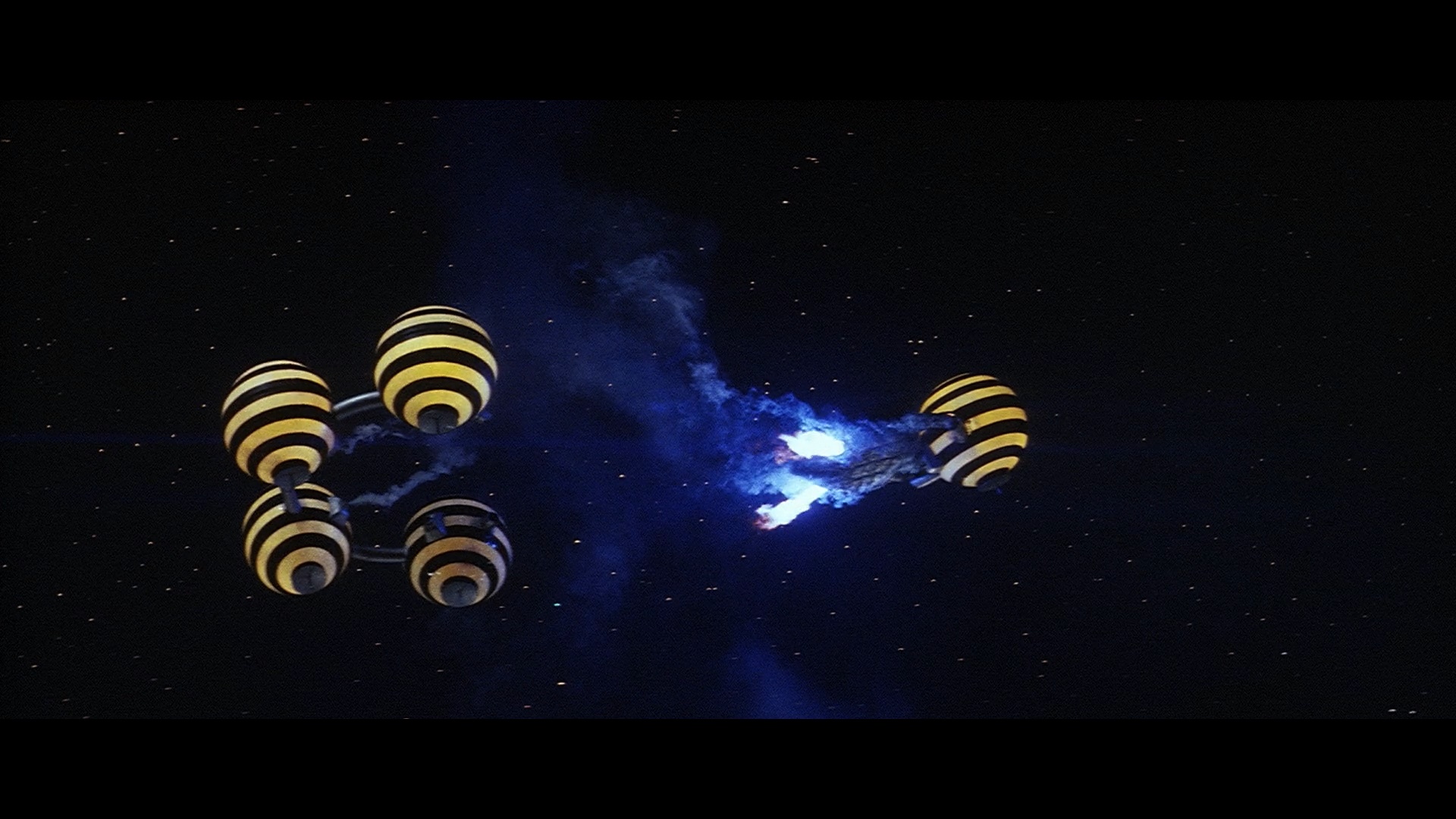 gallery (21m31s).
gallery (21m31s).
The weirder and wildly entertaining Gamera vs. Viras came along next, also known to American TV fans as Destroy All Planets (the title used for various pseudo-PD versions out there including a poor pan-and-scan DVD from Retromedia). This time you get an irresistible combination along 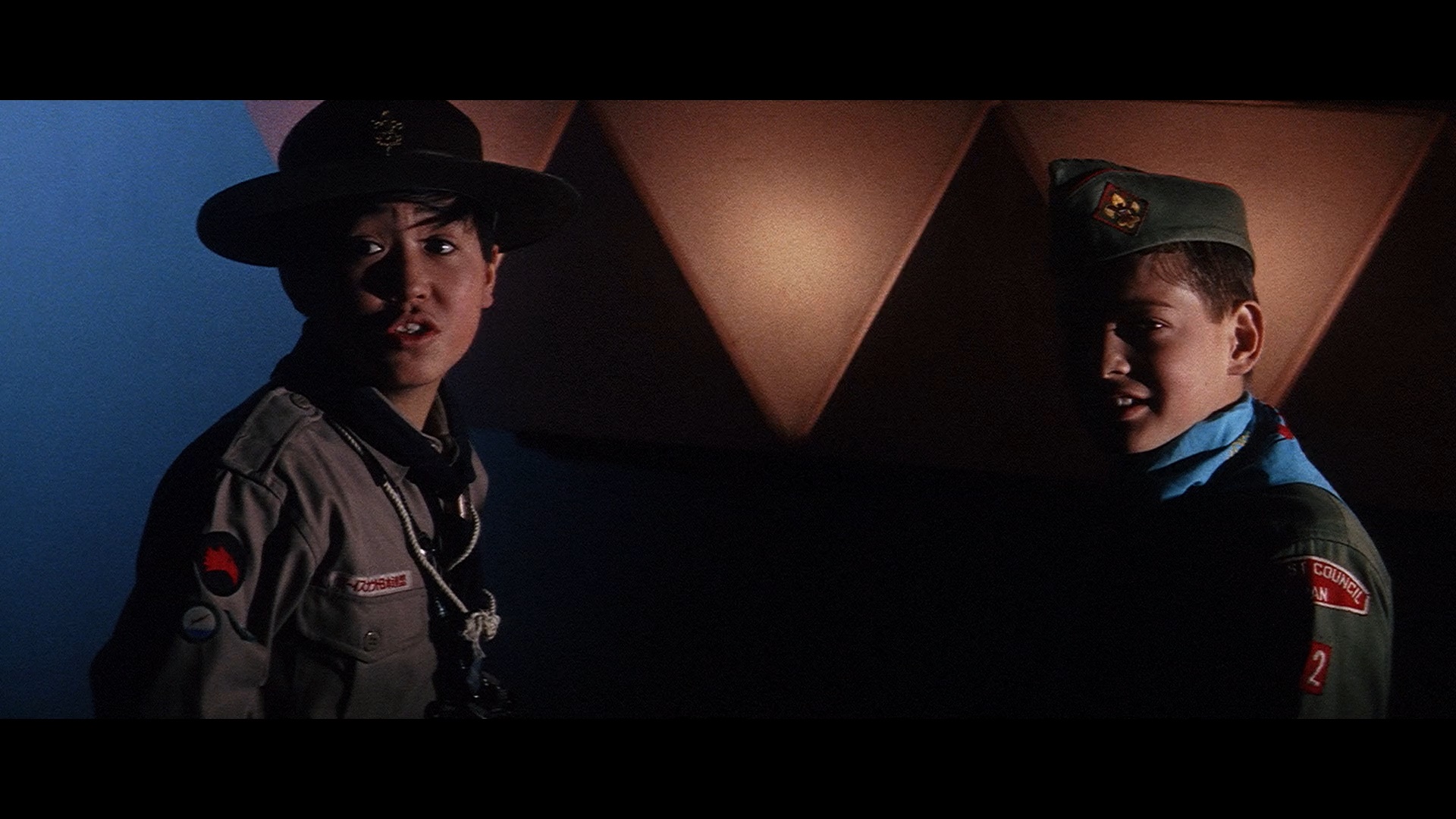 with your usual Gamera antics: aliens and Boy Scouts! See, a spaceship populated by weird-eyed extraterrestrials decides to go after a couple of young scouts (Takatsuka and the obligatory Japanese-speaking American, Craig Jr.), as part of an elaborate plan to have Gamera, their mortal enemy, under their control. Their mind games involve plenty of footage from earlier Gamera antics before our hero faces off against the tentacled alien leader, Viras. This may not be the best Gamera outing, but it might be the nuttiest with some scenes that burst over into full-on surrealism.
with your usual Gamera antics: aliens and Boy Scouts! See, a spaceship populated by weird-eyed extraterrestrials decides to go after a couple of young scouts (Takatsuka and the obligatory Japanese-speaking American, Craig Jr.), as part of an elaborate plan to have Gamera, their mortal enemy, under their control. Their mind games involve plenty of footage from earlier Gamera antics before our hero faces off against the tentacled alien leader, Viras. This may not be the best Gamera outing, but it might be the nuttiest with some scenes that burst over into full-on surrealism.
In this case you get three viewing options: the theatrical version (72m), the "director's version" (81m), and the extended U.S. version (90m). A really great and oddly 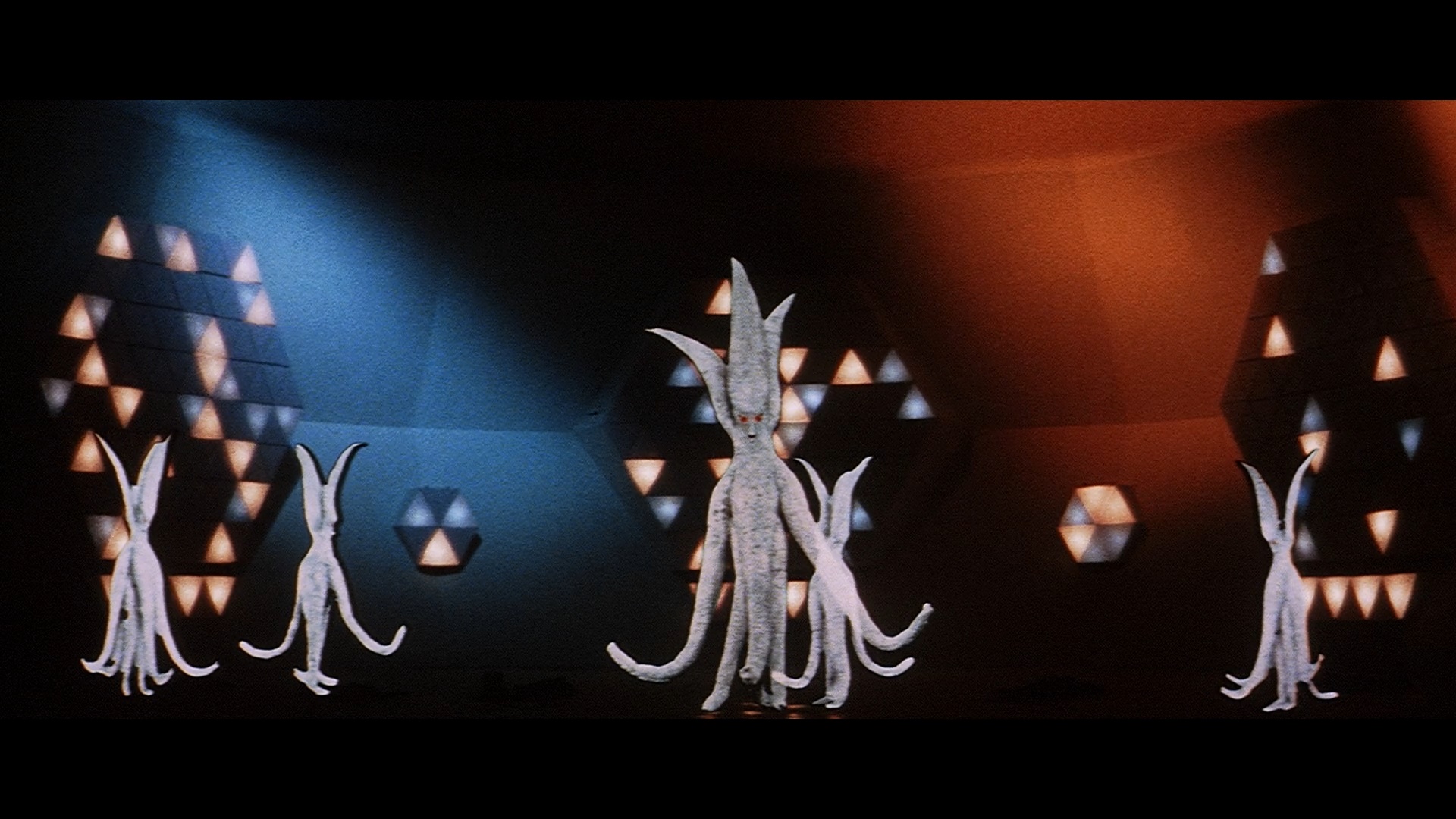 touching new audio commentary by Carl Craig and Jim Cirronella, a Ragone intro (11m14s) explaining the story behind the different versions due to AIP's running time requirements for this "cosmic calamari wrestling match," a new "52 Years Later" featurette (12m29s) with Craig showing off his souvenirs from the film including props, extensive G-Fest 2003 highlights with Noriaki Yuasa and Craig (60m59s), The 4th
touching new audio commentary by Carl Craig and Jim Cirronella, a Ragone intro (11m14s) explaining the story behind the different versions due to AIP's running time requirements for this "cosmic calamari wrestling match," a new "52 Years Later" featurette (12m29s) with Craig showing off his souvenirs from the film including props, extensive G-Fest 2003 highlights with Noriaki Yuasa and Craig (60m59s), The 4th  Nippon Jamboree (6m18s) featuring a young Yuasa just before making the film for Japan's Boy Scouts, the alternate English Destroy credits, the Japanese trailer, a U.S. TV spot, and another big gallery (18m11s).
Nippon Jamboree (6m18s) featuring a young Yuasa just before making the film for Japan's Boy Scouts, the alternate English Destroy credits, the Japanese trailer, a U.S. TV spot, and another big gallery (18m11s).
Even more than before, the series morphed into a full-on psychotic kids' playground with Gamera vs. Guiron, unimaginatively retitled for American TV audiences as Attack of the Monsters. Again we have a pair of kids and some aliens, not to mention a plot set up that seems suspiciously familiar. Some androgynous aliens planning to takeover Earth swipe the two children (Kajima and Murphy) and take them to their home planet, which is defended primarily by a truly bizarre monster, Guiron, with a head shaped like a giant blade. Luckily Gamera is hot on their trail, and the story essentially spins off 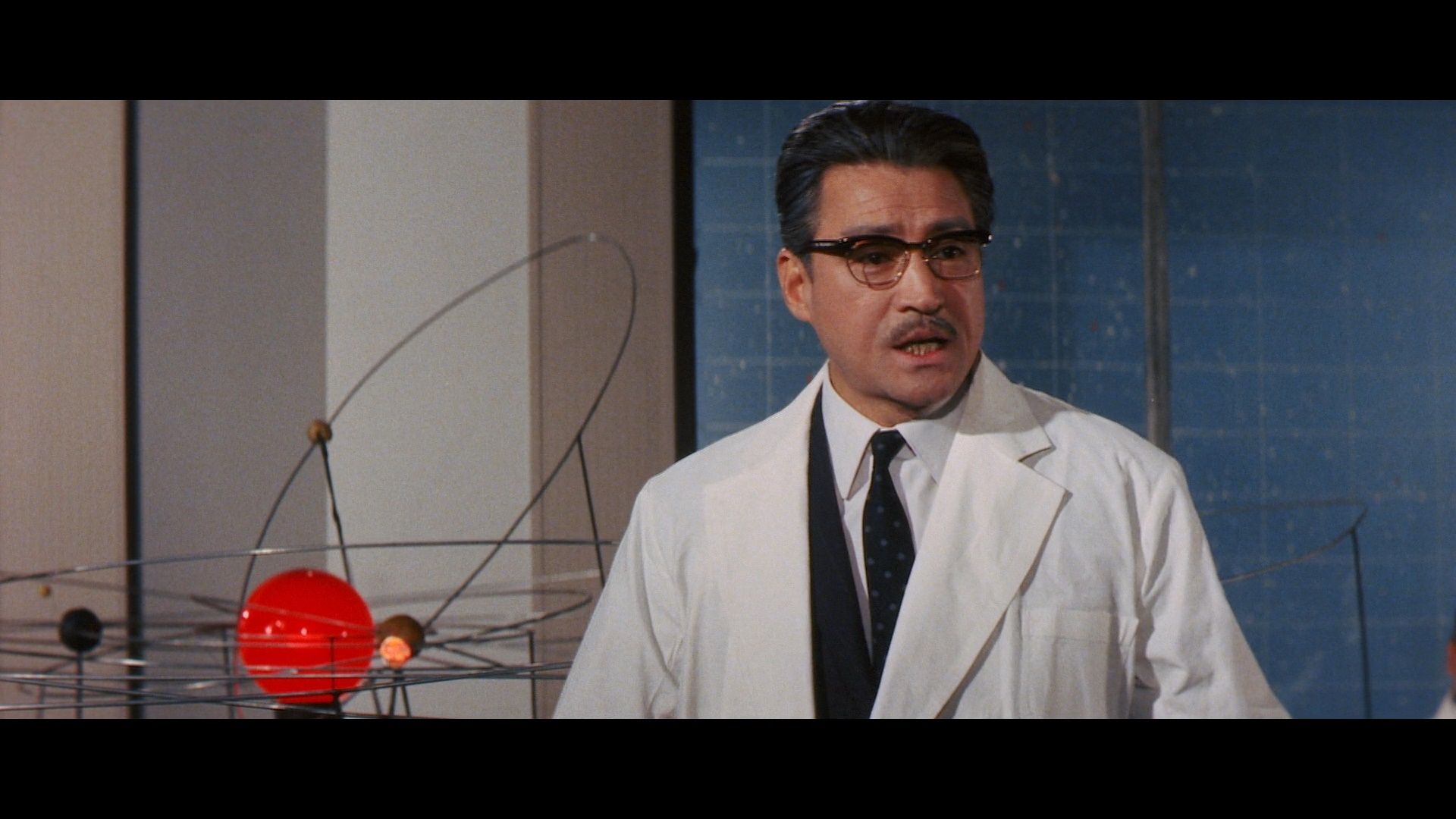 into a string of monster face-offs as the kids and aliens root for opposing sides. The striking monster (who looks like a shark mutated with a Ginsu knife) is the real star here along with some freaky outer space visuals, and again, if you don't mind the kid-aiming storyline and increasingly ridiculous cost-cutting, this one delivers the
into a string of monster face-offs as the kids and aliens root for opposing sides. The striking monster (who looks like a shark mutated with a Ginsu knife) is the real star here along with some freaky outer space visuals, and again, if you don't mind the kid-aiming storyline and increasingly ridiculous cost-cutting, this one delivers the 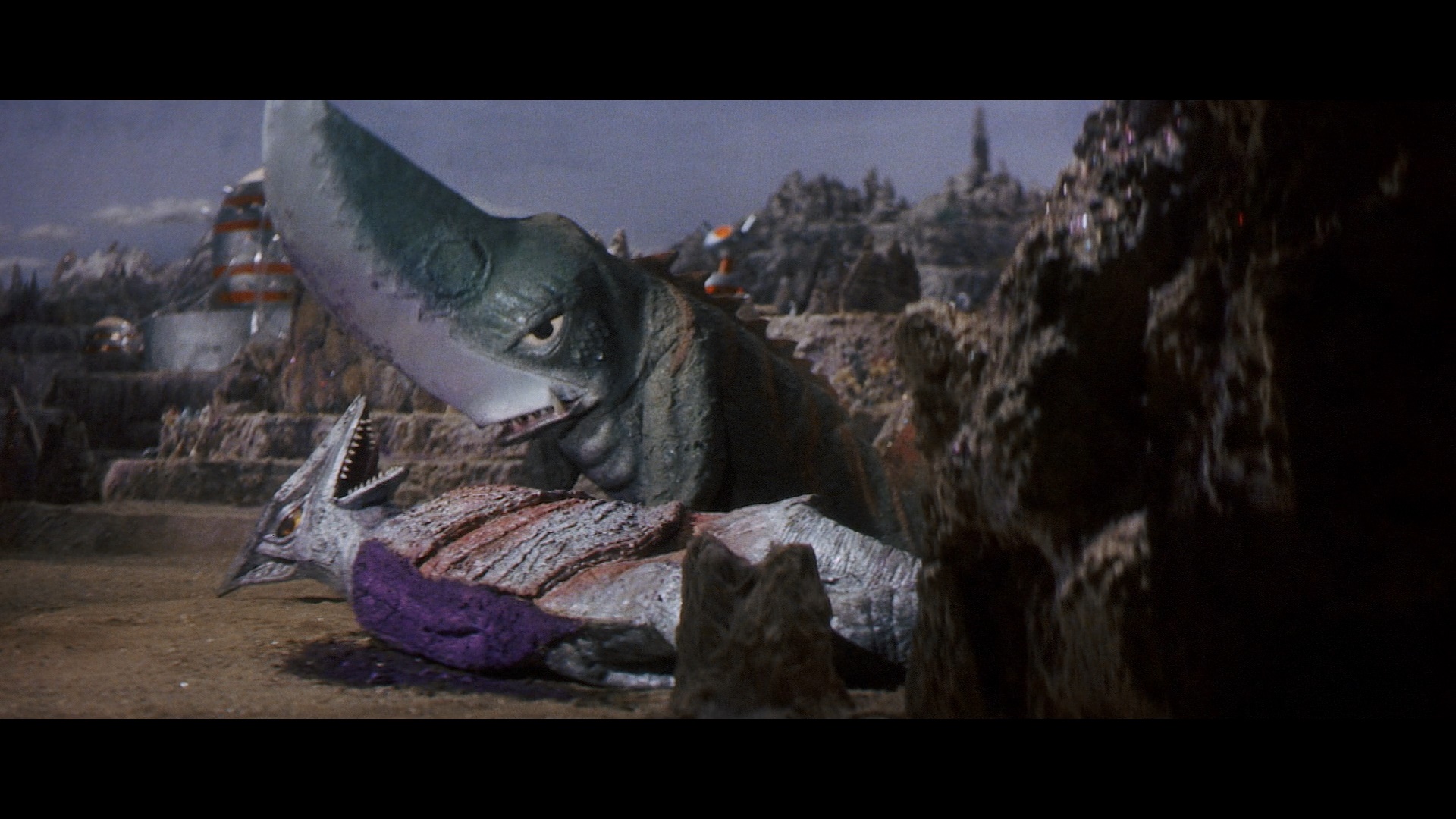 rubber-suited goods. It's also a bit more gruesome than usual including a protracted monster dismemberment (albeit with a highly unnatural blood color) that had AIP scrambling for the censor scissors when this first hit stateside television.
rubber-suited goods. It's also a bit more gruesome than usual including a protracted monster dismemberment (albeit with a highly unnatural blood color) that had AIP scrambling for the censor scissors when this first hit stateside television.
Again the presentation here is top notch with image quality up to par once again and both the Japanese and English tracks included with optional English subtitles. Former AllDay owner and Japanese fantastic cinema scholar David Kalat provides a fine audio commentary, and you also get a new Ragone intro (11m25s), the alternate English credits for the AIP and Sandy Howard releases, the Japanese trailer, a U.S. TV spot, an image gallery (10m30s), and a Neptune Media Archive gallery (6m40s).
By the start of the '70s, the demand by international distributors 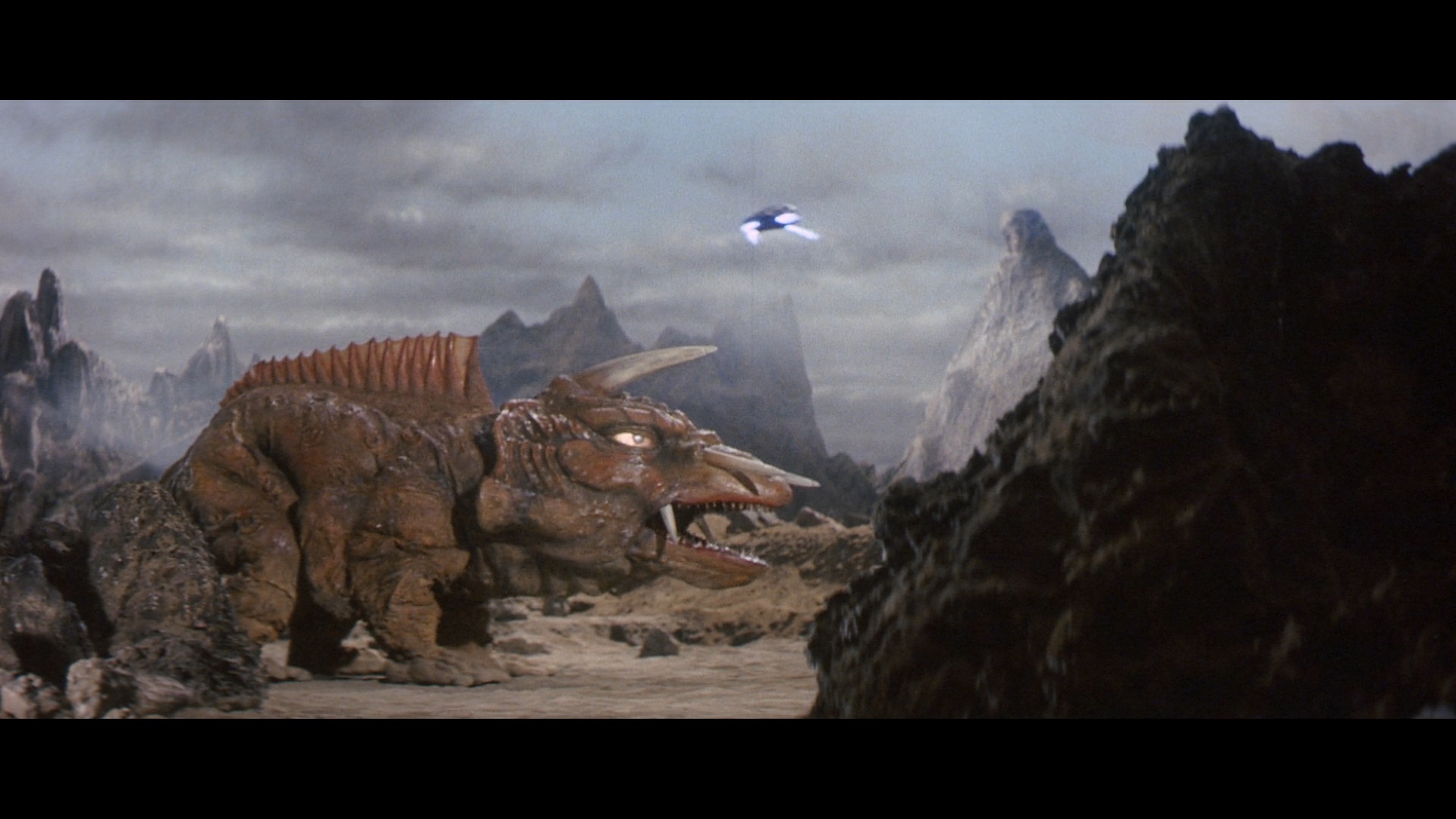 for a Gamera adventure each year was starting to show some wear and tear on the productions. However, the next two films at least managed to keep the wheels from coming off the cart by delivering some kid-friendly perils and enough Gamera action to
for a Gamera adventure each year was starting to show some wear and tear on the productions. However, the next two films at least managed to keep the wheels from coming off the cart by delivering some kid-friendly perils and enough Gamera action to 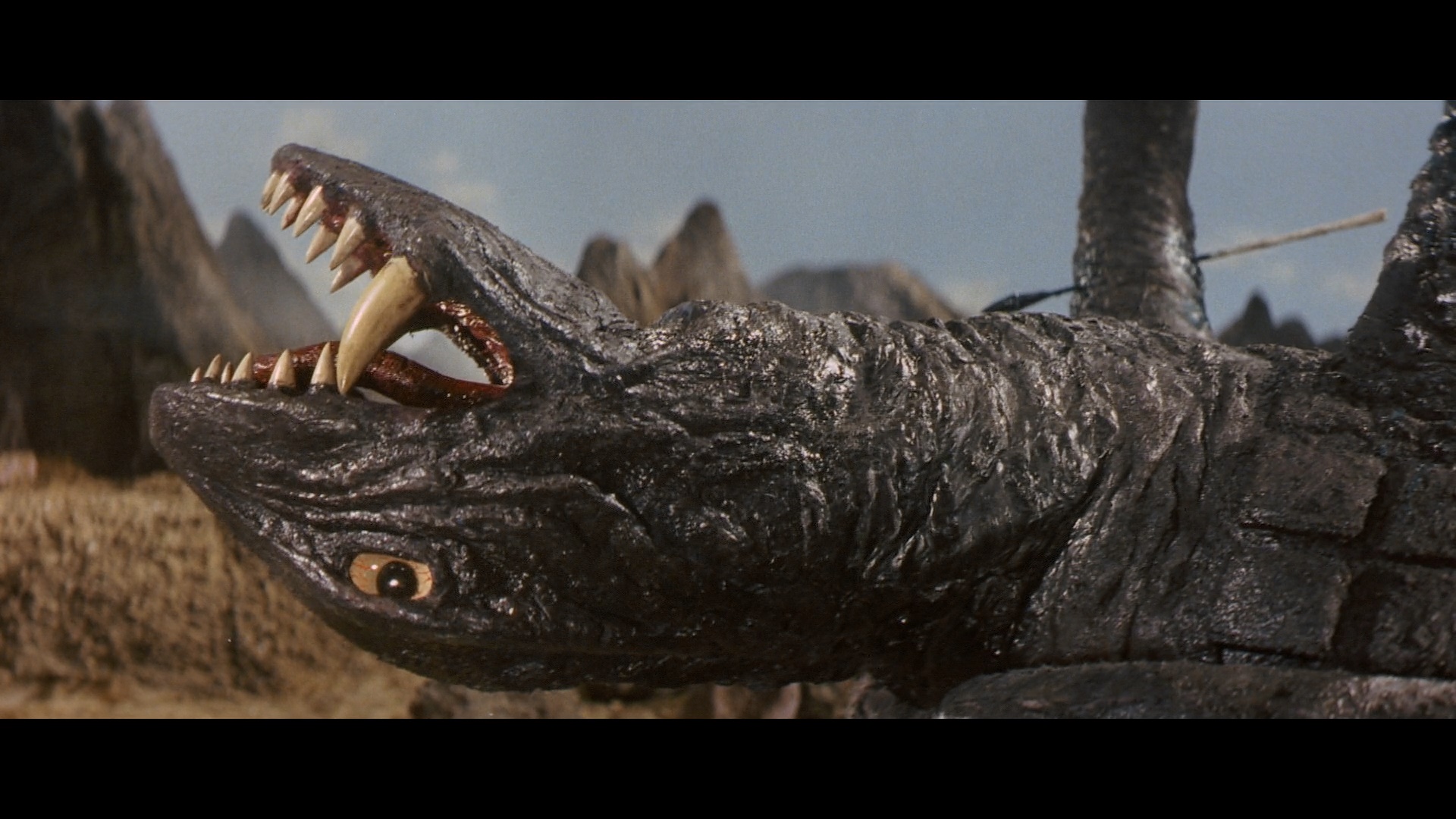 keep fans happy. Gamera vs. Jiger features the big turtle stomping around trying to stop the citizens of Osaka from hauling out a big statue to celebrate their hosting of an upcoming expo. Not surprisingly, it turns out everyone should have heeded his reptilian advice because this move unleashes a wrinkled, tusked, dinosaur-like beast called Jiger who blasts heat rays and stings with his tail. Gamera seems to be mortally wounded in his initial fight, but once again it's up to two plucky kids (Varis and Takakuma) to figure out what's ailing their giant friend and revive him enough to face off once again against his foe before the entire island goes up in flames. Complete with a hallucinatory sequence involving a toy submarine (with a surprise medical revelation) and lots of rousing battle scenes, this entertaining and action-packed entry (also known as Gamera vs. Monster X) is another fun one if visibly aiming for an even younger audience than before.
keep fans happy. Gamera vs. Jiger features the big turtle stomping around trying to stop the citizens of Osaka from hauling out a big statue to celebrate their hosting of an upcoming expo. Not surprisingly, it turns out everyone should have heeded his reptilian advice because this move unleashes a wrinkled, tusked, dinosaur-like beast called Jiger who blasts heat rays and stings with his tail. Gamera seems to be mortally wounded in his initial fight, but once again it's up to two plucky kids (Varis and Takakuma) to figure out what's ailing their giant friend and revive him enough to face off once again against his foe before the entire island goes up in flames. Complete with a hallucinatory sequence involving a toy submarine (with a surprise medical revelation) and lots of rousing battle scenes, this entertaining and action-packed entry (also known as Gamera vs. Monster X) is another fun one if visibly aiming for an even younger audience than before. 
Packed with the two subsequent films in the set on one Blu-ray for the Arrow release (which is fine given the short running times and fewer extras), Gamera vs. Jiger sports comparable image and audio quality here -- no complaints really -- with Japanese and English LPCM 1.0 mono tracks, 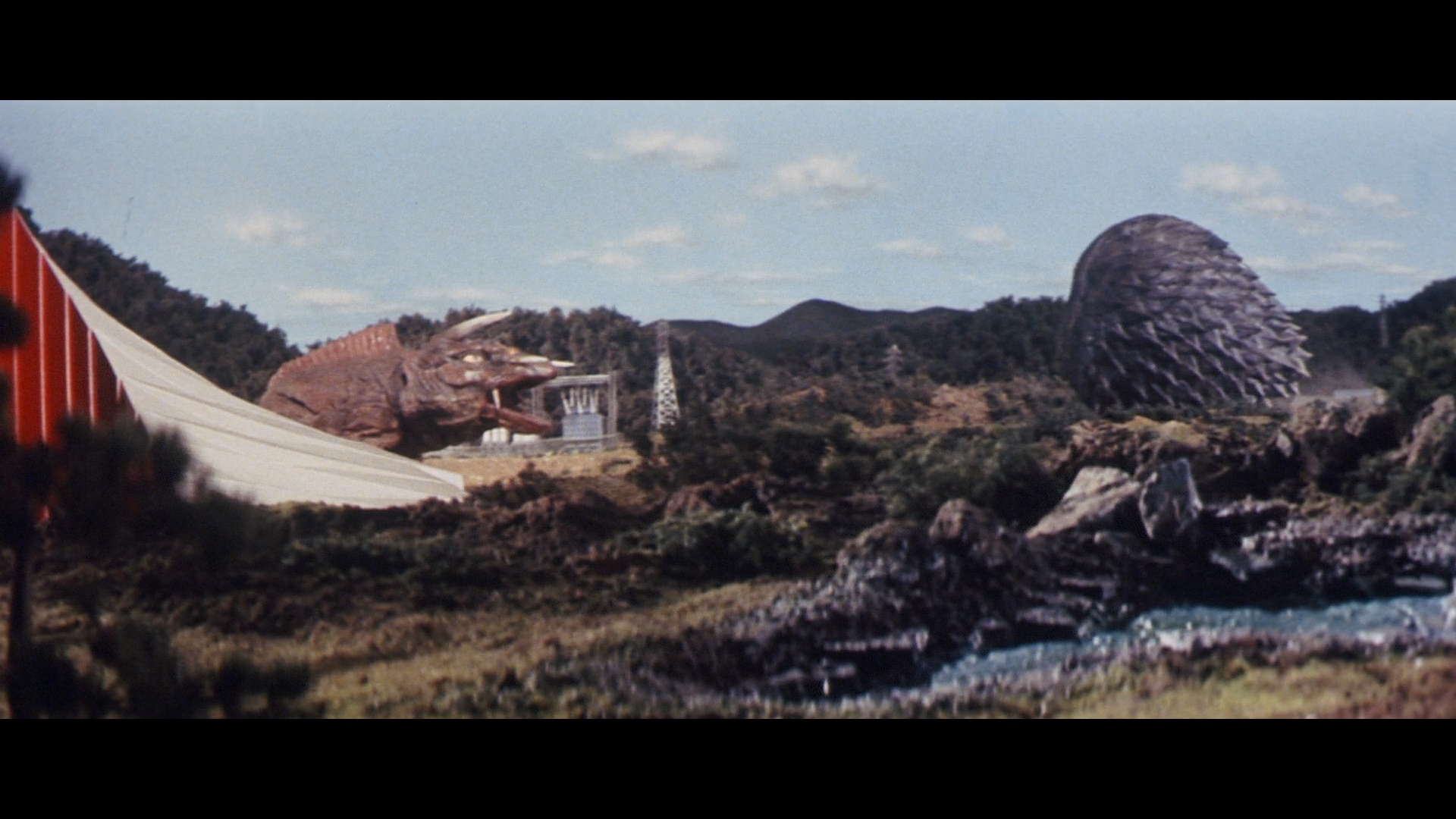 subs, and a new audio commentary by Edward H. Holland who goes into the cultural appeal of the expo setting, the international distribution (including its U.S. run as Gamera vs. Monster X), and his increased appreciation for the film over the years. He sometimes lapses into going quiet or just reacting to the action on screen for a few stretches, but there's still good info here to glean. Also included are a Ragone intro (8m39s) focusing on the real expo conveniently used as the story backdrop, the alternate English TV credits, the Japanese and German trailers (the latter doing its damnedest to pass of Jigar as "the biggest of Frankenstein's monsters"), a U.S. TV spot, and an image gallery (20m41s).
subs, and a new audio commentary by Edward H. Holland who goes into the cultural appeal of the expo setting, the international distribution (including its U.S. run as Gamera vs. Monster X), and his increased appreciation for the film over the years. He sometimes lapses into going quiet or just reacting to the action on screen for a few stretches, but there's still good info here to glean. Also included are a Ragone intro (8m39s) focusing on the real expo conveniently used as the story backdrop, the alternate English TV credits, the Japanese and German trailers (the latter doing its damnedest to pass of Jigar as "the biggest of Frankenstein's monsters"), a U.S. TV spot, and an image gallery (20m41s).
In Gamera vs. Zigra, the last of the series for a whopping nine years, the environmental activism that was sweeping the world hit Japan with two simultaneous kaiju films: 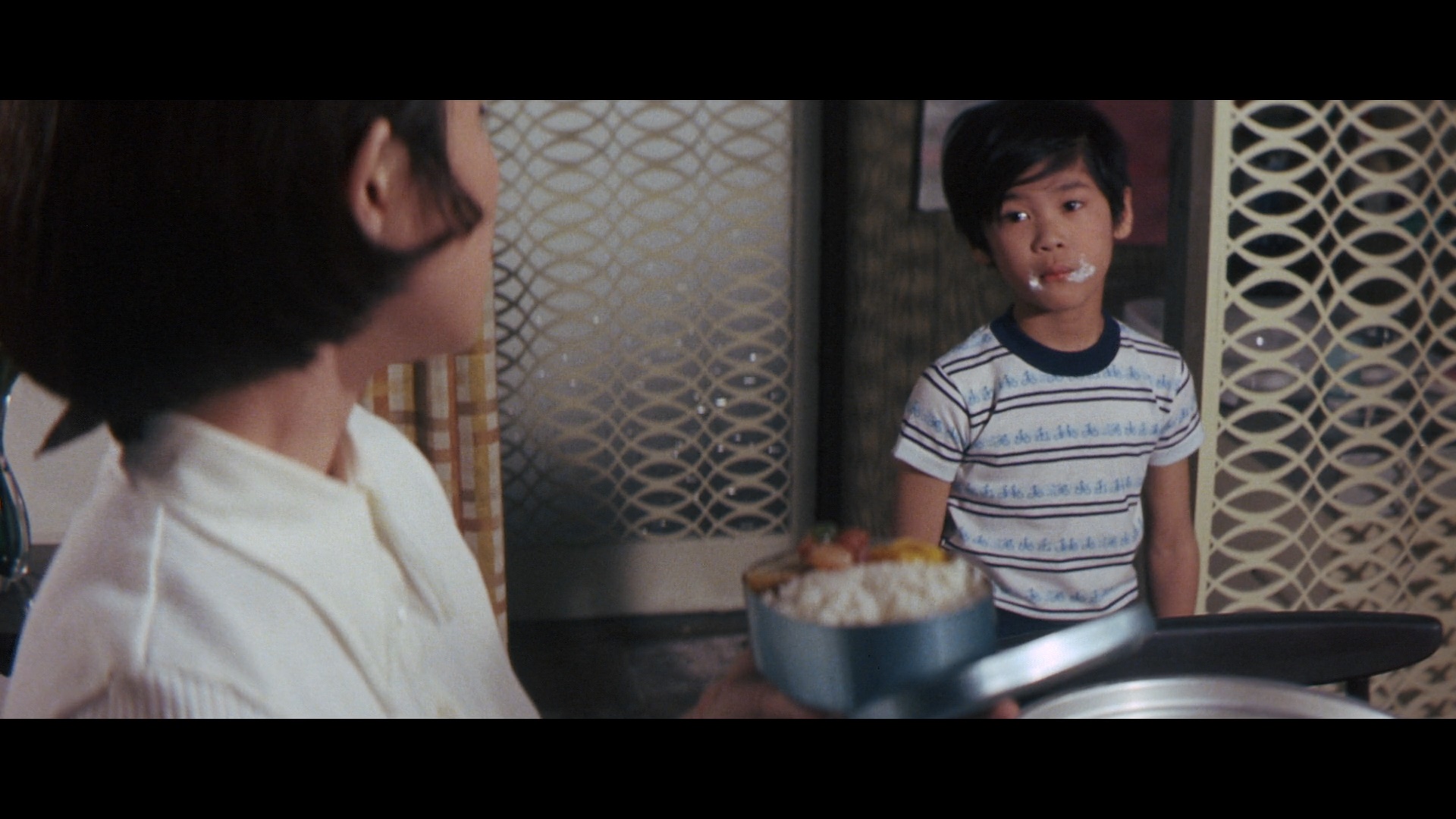 this one and Godzilla vs. Hedorah, a.k.a. Godzilla vs. the Smog Monster, both pleading for man to take responsibility for being caretakers of the planet. Here the action starts with a couple of earthquakes rocking the globe and two marine biologists fretting about pollution of the oceans.
this one and Godzilla vs. Hedorah, a.k.a. Godzilla vs. the Smog Monster, both pleading for man to take responsibility for being caretakers of the planet. Here the action starts with a couple of earthquakes rocking the globe and two marine biologists fretting about pollution of the oceans.  During an afternoon out getting samples on a boat, their two respective young children, Kenichi and Helen, stow away to join the fun. In the process they're abducted by an alien ship belonging to the Zigrans, an aquatic alien race who want to take over the Earth and use humans as their food supply. Their female representative (Yanami) is actually a lunar explorer temporarily taken over by the invaders, and it's up to Gamera to save the day -- especially when the now marooned Zigran ship turns into a blade-headed monster bent on destruction.
During an afternoon out getting samples on a boat, their two respective young children, Kenichi and Helen, stow away to join the fun. In the process they're abducted by an alien ship belonging to the Zigrans, an aquatic alien race who want to take over the Earth and use humans as their food supply. Their female representative (Yanami) is actually a lunar explorer temporarily taken over by the invaders, and it's up to Gamera to save the day -- especially when the now marooned Zigran ship turns into a blade-headed monster bent on destruction.
Daiei was on its last legs during the making of this film with an even lower budget than the prior entries, but it's still plenty entertaining with novel use made of an aquatic park and Gamera engaging in some rousing rumbles with his alien foe. The Arrow presentation is another winner featuring the Japanese and English mono tracks (the latter sounding cruddier than usual as it always has), with 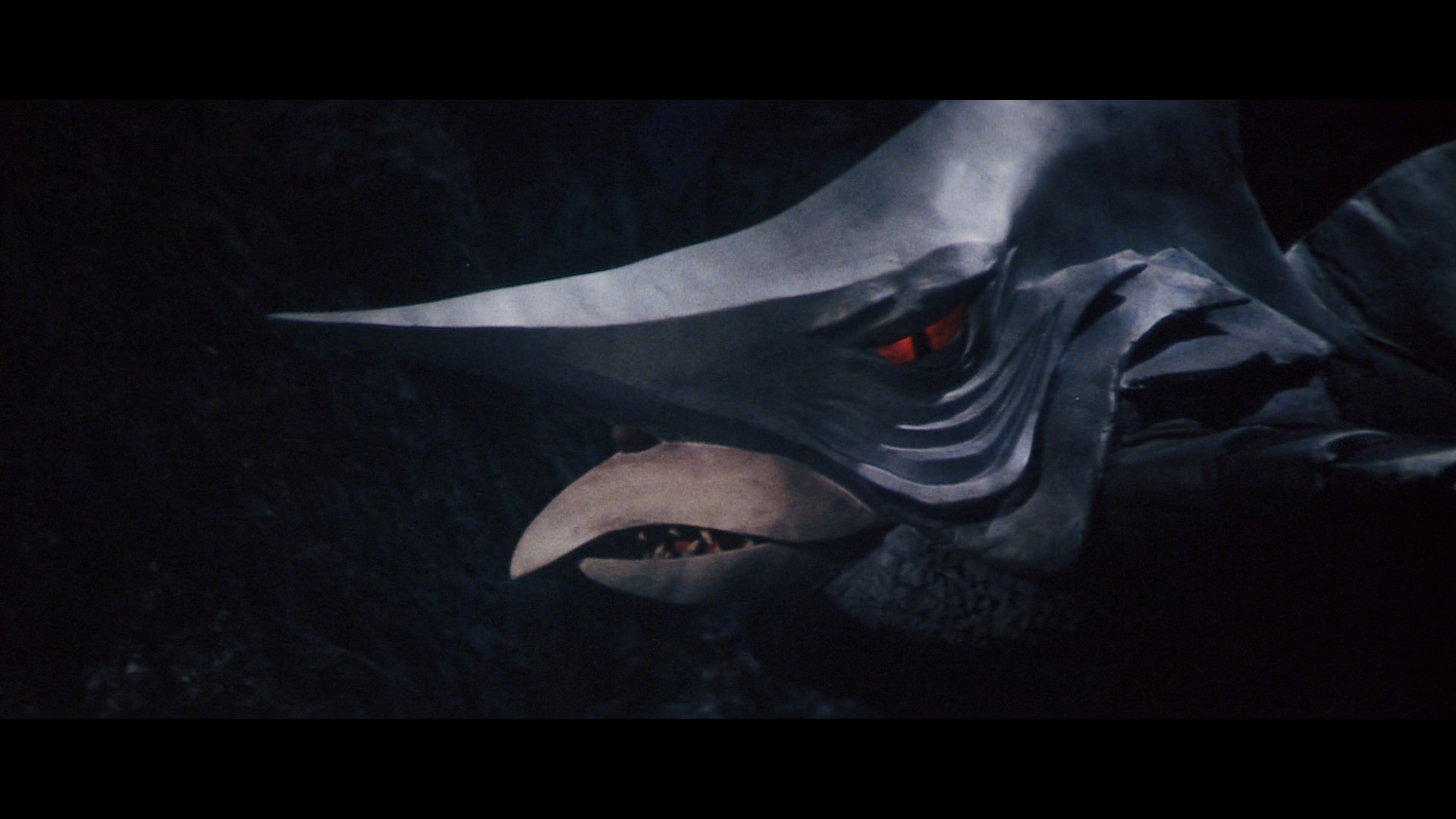 optional English subtitles and a new audio commentary by Sean Rhoads and Brooke McCorkle who very enthusiastically tackle this film appreciating its miniatures, ecological concerns, the current events that informed the script, and the design choices for the spaceship and monsters. Also included are a
optional English subtitles and a new audio commentary by Sean Rhoads and Brooke McCorkle who very enthusiastically tackle this film appreciating its miniatures, ecological concerns, the current events that informed the script, and the design choices for the spaceship and monsters. Also included are a 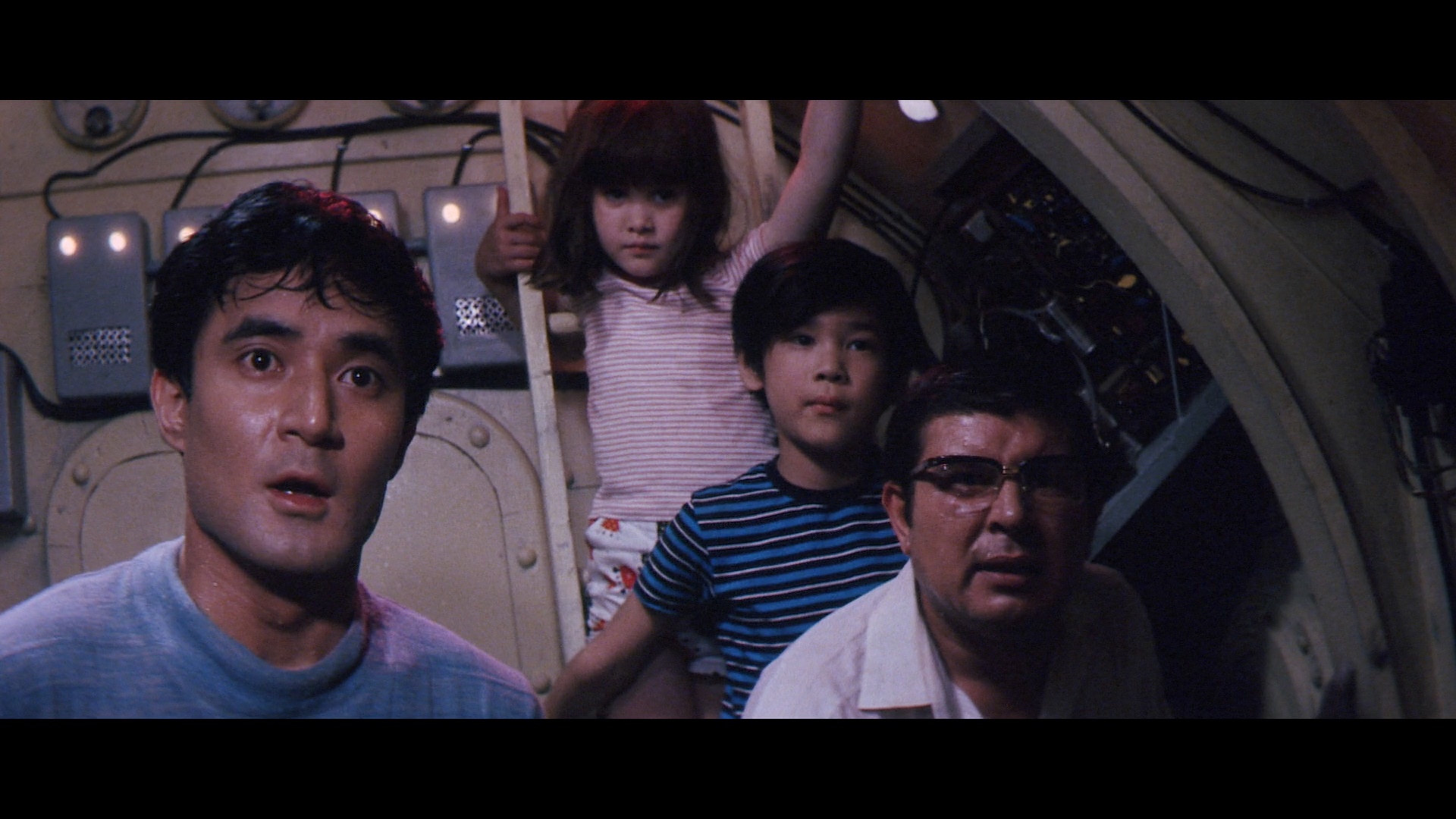 Ragone intro (8m23s), alternate English credits, the Japanese trailer, a U.S. video promo, and an image gallery (15m20s).
Ragone intro (8m23s), alternate English credits, the Japanese trailer, a U.S. video promo, and an image gallery (15m20s).
Almost universally considered the low point of the series, Gamera Super Monster arrived in 1980 from a new incarnation of Daiei with Yuasa returning one last time for what amounts of a glorified clip show masquerading as a feature film. Shot flat in marked contrast to all of its scope predecessors and featuring some cruddy video effects and cheap paintings posing as effects shots. The story is essentially a rehash of familiar elements as the alien "messenger of death" ship Zanon charts a course for Earth, with a trio of secret galactic guardians including a schoolteacher, a pet shop owner, and a car dealer slipping into their secret superhero outfits to fly to the rescue. However, even with a flying van they're still in big trouble against the alien force that booms instructions directly to them. Cue the stock footage as wicked emissary Giruge (Kudo) arranges an onslaught of monsters to fight the beloved Gamera in a variety of very familiar-looking showdowns.
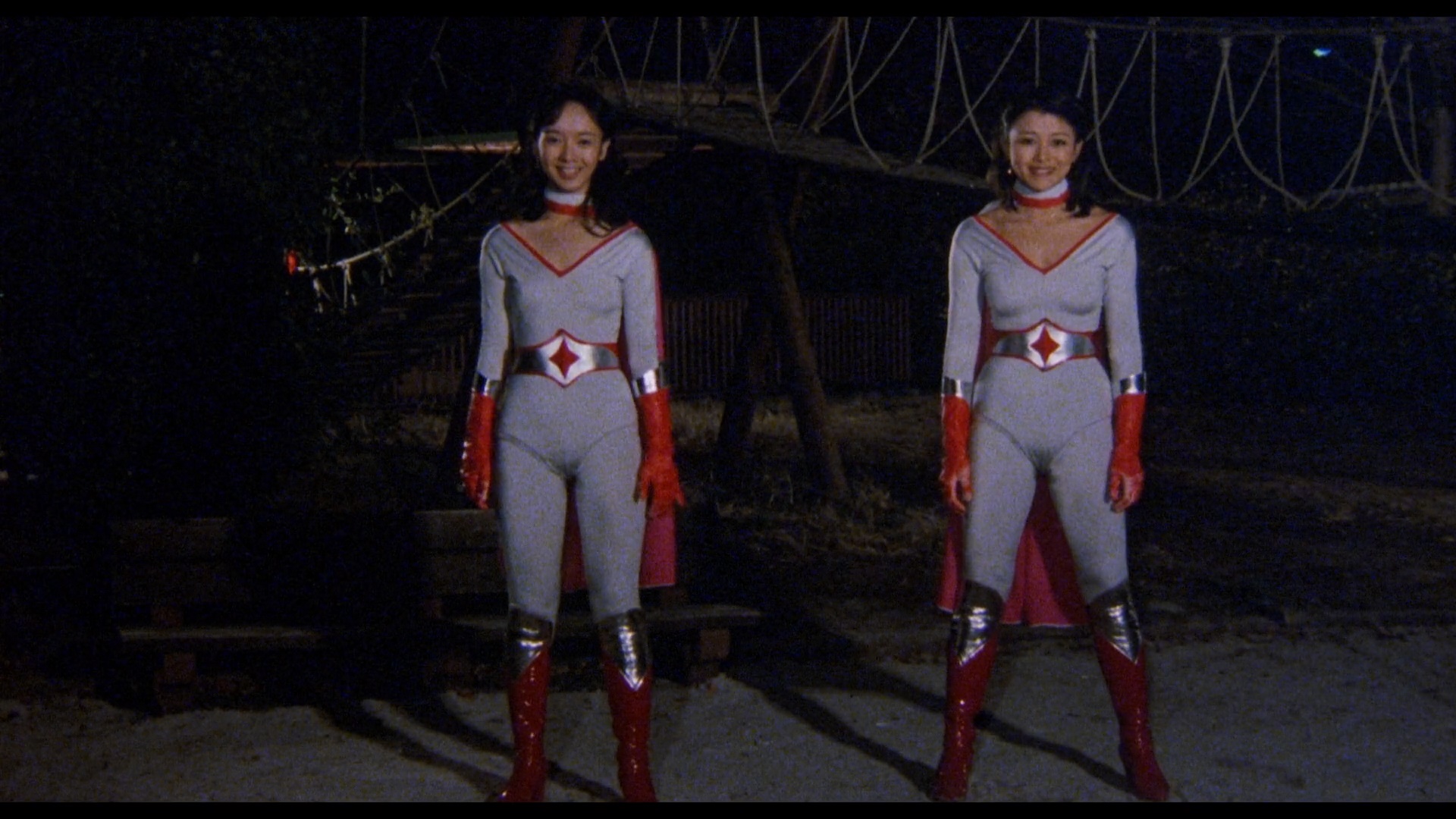 Complete with a Casio rendition of "Camptown Races" and the obligatory turtle-worshiping cute kids, this is a deeply odd film though not one without its charms if you keep your expectations very low. Again the Arrow presentation looks as good as it possibly could, with the
Complete with a Casio rendition of "Camptown Races" and the obligatory turtle-worshiping cute kids, this is a deeply odd film though not one without its charms if you keep your expectations very low. Again the Arrow presentation looks as good as it possibly could, with the 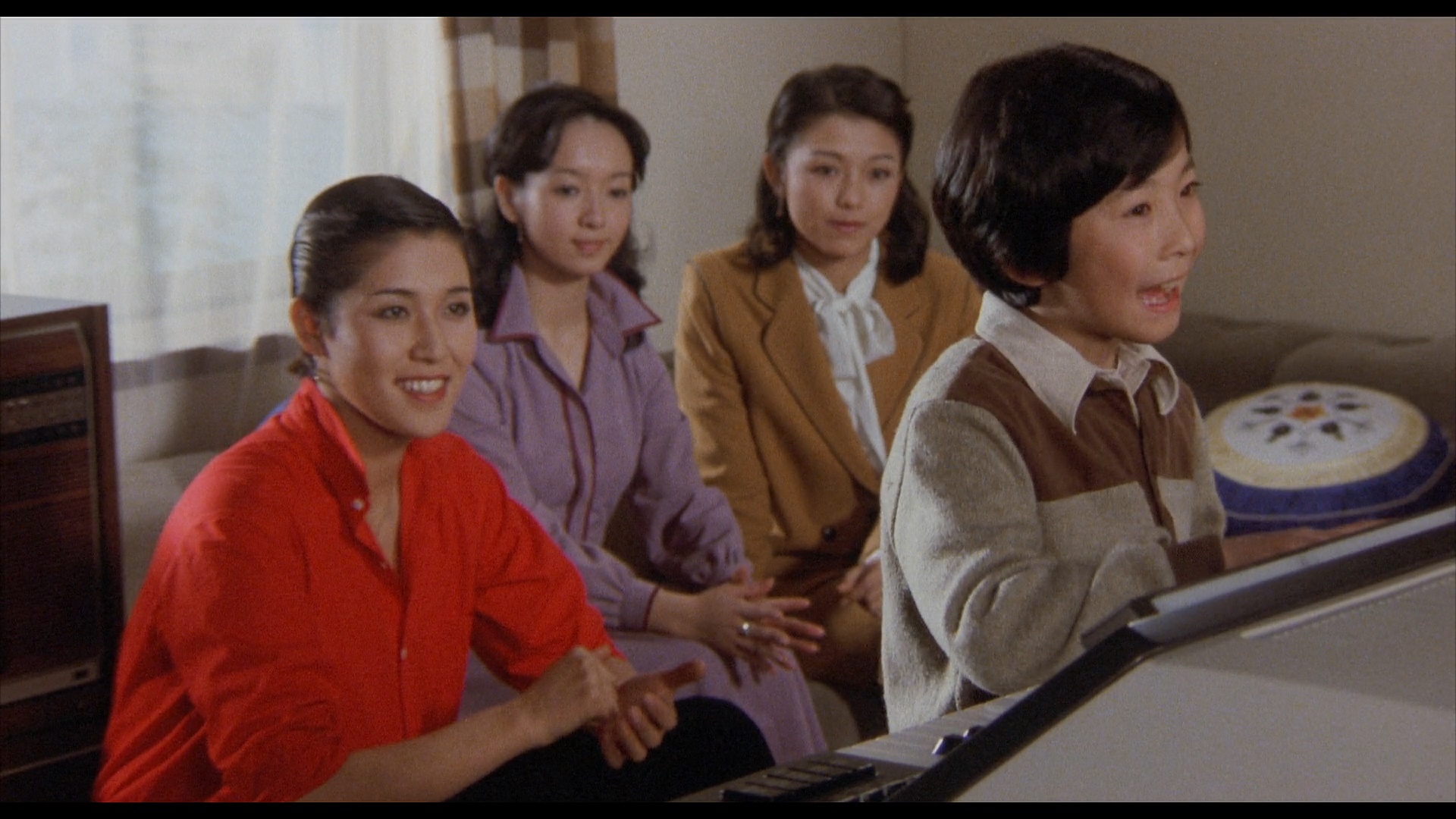 original film footage faring quite well when it isn't overlaid with those video effects. The Japanese and English tracks are here of course with optional English subtitles, and Richard Pusateri provides an informed audio commentary trying to parse out exactly how this patchwork production came to be. Again you get a Ragone intro (6m5s) about the musical and Sid & Marty Krofft vibe of the project, as well as the colorful other careers of our three superwomen from pop music to female wrestling, plus two alternate English credits (16mm and VHS), the Japanese and English trailers, and an image gallery (7m50s).
original film footage faring quite well when it isn't overlaid with those video effects. The Japanese and English tracks are here of course with optional English subtitles, and Richard Pusateri provides an informed audio commentary trying to parse out exactly how this patchwork production came to be. Again you get a Ragone intro (6m5s) about the musical and Sid & Marty Krofft vibe of the project, as well as the colorful other careers of our three superwomen from pop music to female wrestling, plus two alternate English credits (16mm and VHS), the Japanese and English trailers, and an image gallery (7m50s).
Though Godzilla remained intermittently active in the ensuing years, Gamera remained in hibernation after the Showa era until his unlikely resurrection in 1995 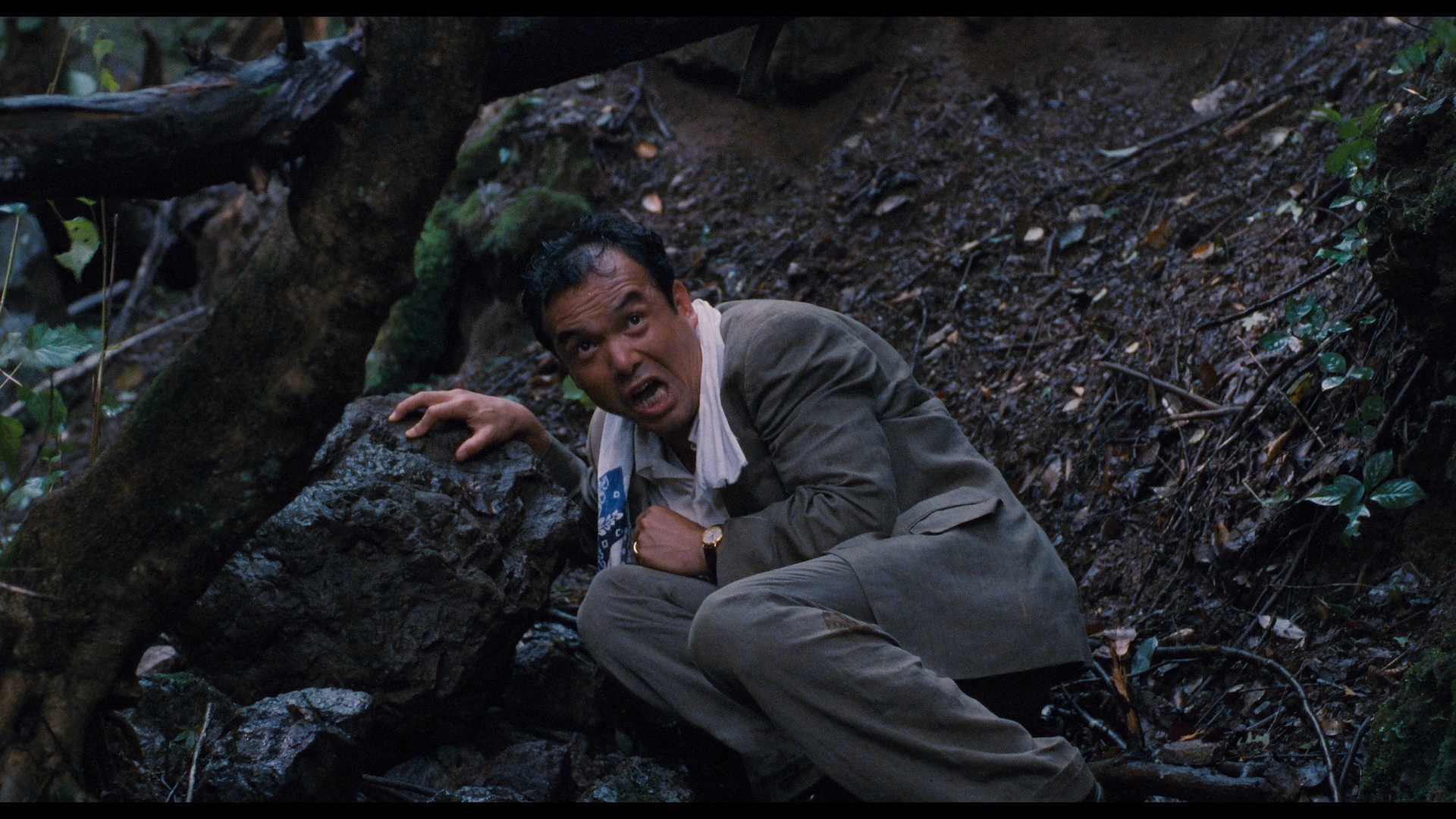 with a trio of films that caught everyone off guard. Starting with Gamera: Guardian of the Universe in 1995, upcoming director Shûsuke Kaneko delivered a new series over the course of four years that upped the ante for kaiju productions in general with spectacular action sequences, impressive effects, and genuinely interesting stories for the human characters. The first film even earned a U.S. theatrical release, a
with a trio of films that caught everyone off guard. Starting with Gamera: Guardian of the Universe in 1995, upcoming director Shûsuke Kaneko delivered a new series over the course of four years that upped the ante for kaiju productions in general with spectacular action sequences, impressive effects, and genuinely interesting stories for the human characters. The first film even earned a U.S. theatrical release, a 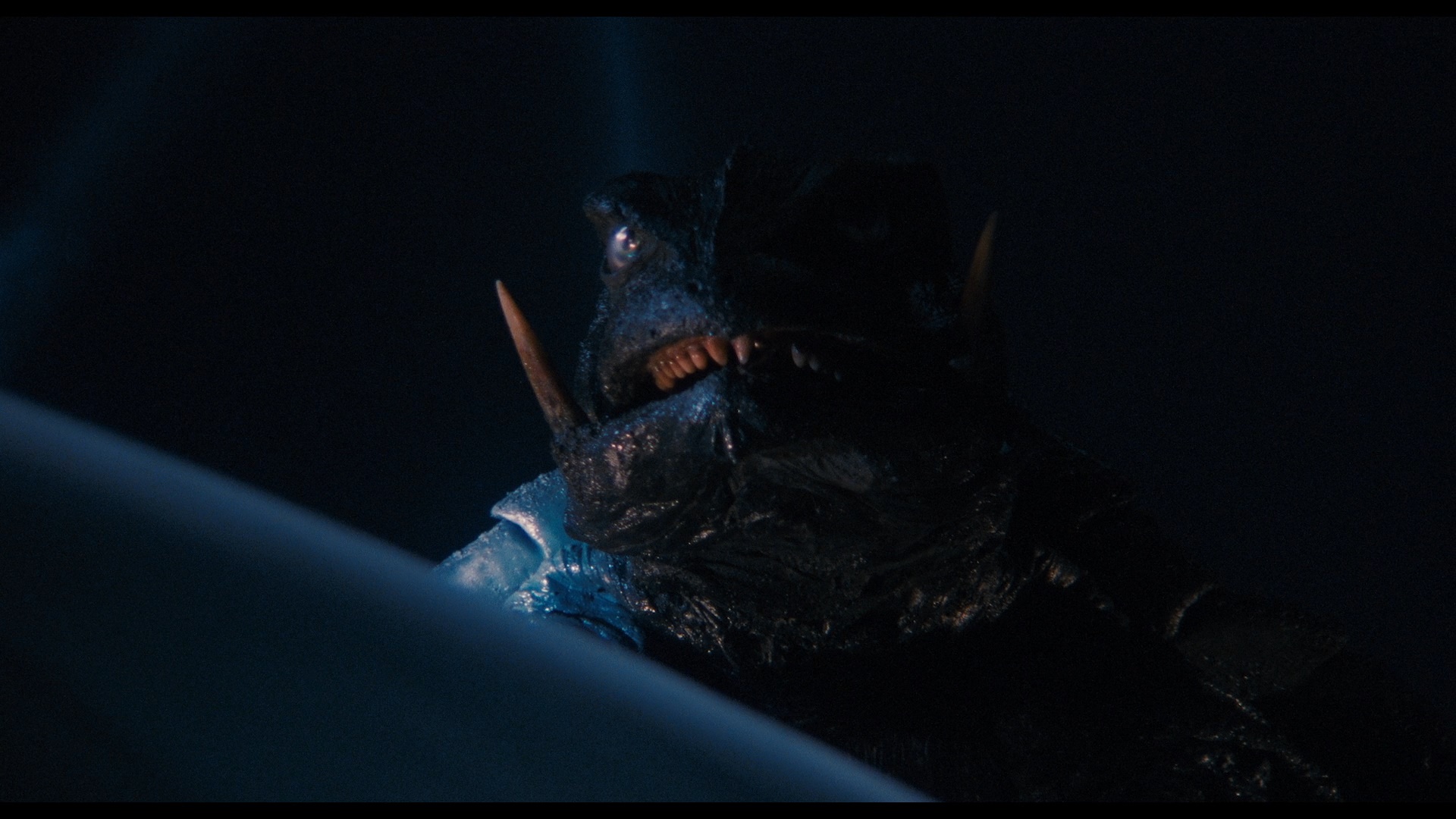 real rarity at the time, and the trilogy has since remained a fond favorite. Opening up with the both the Toho and Daiei logos (for complex reasons addressed on the disc), Guardian requires no previous familiarity with the series and makes for a roaring start as old foe Gyaos emerges on HImegami Island and starts wreaking havoc around Fukuoaka which necessitates a distress call to Gamera (newly awakened beneath the waves by a stray Japanese ship), leading to a series of conflicts that soon move to the heart of Tokyo. A psychic bond with young Asagi (Fujitani) helps Gamera's intentions remain clear to the humans caught in the middle, who witness an increasingly epic battle erupting before them.
real rarity at the time, and the trilogy has since remained a fond favorite. Opening up with the both the Toho and Daiei logos (for complex reasons addressed on the disc), Guardian requires no previous familiarity with the series and makes for a roaring start as old foe Gyaos emerges on HImegami Island and starts wreaking havoc around Fukuoaka which necessitates a distress call to Gamera (newly awakened beneath the waves by a stray Japanese ship), leading to a series of conflicts that soon move to the heart of Tokyo. A psychic bond with young Asagi (Fujitani) helps Gamera's intentions remain clear to the humans caught in the middle, who witness an increasingly epic battle erupting before them.
A true game changer, Guardian set the stage for modern kaiju films including superb model work that simply wouldn't have packed the same punch with CGI. Fans continue to debate which of the three is the best, though there's no doubt that this is the most important as it established the key ingredients that made Gamera a hit  for a new generation without being saddled with the kid-friendly label that become something of an obstacle for a reboot to that point. The Arrow release compiles pretty much everything extras-wise
for a new generation without being saddled with the kid-friendly label that become something of an obstacle for a reboot to that point. The Arrow release compiles pretty much everything extras-wise 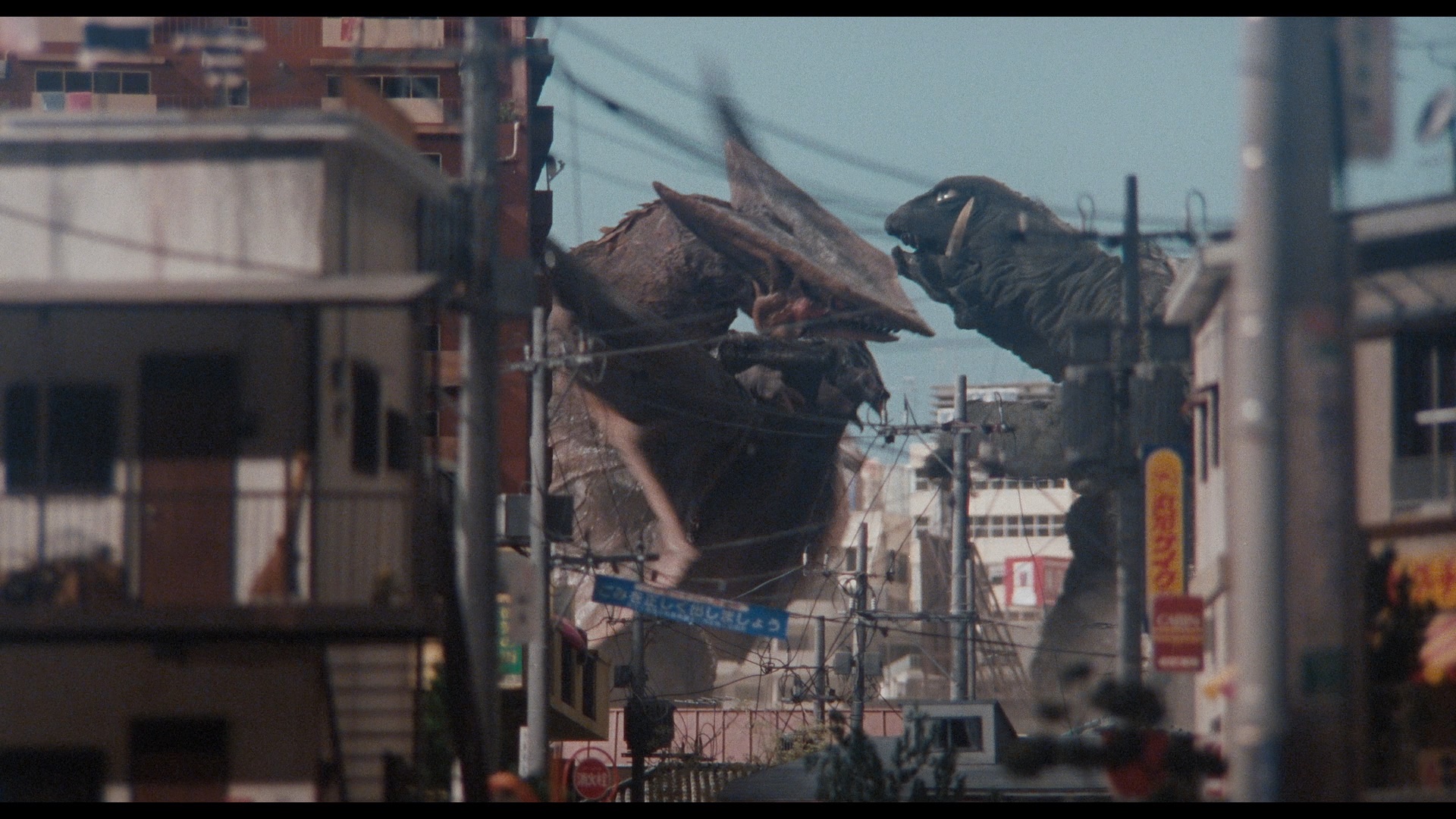 around for this film along with some new goodies, while the HD transfer is excellent as it has always been since created by Daiei. Audio options include the very active Japanese (5.1 and 2.0), U.S. English (5.1 and 2.0), and U.K. English (2.0) tracks with optional English subtitles, plus an audio commentary by Matt Frank (who did the spectacular artwork design for this set) who goes into everything from the necessity for the character played by Fujitani (who's also Steven Seagal's daughter) to the intricate circumstances behind the film's creation including the wholesale rejection of an earlier concept. Video extras include a Ragone intro (4m34s), the epic "A Testimony of 15 Years: Part 1" (115m47s) from the three-part 2010 retrospective documentary series with pretty much every available participant, a reel of Buttgereit interviews with director Shusuke Kaneko and FX director Shinji Higuchi (35m48s), a separate standalone exhaustive interview with Higuchi (92m42s) from 2001, a vintage behind-the-scenes featurette (16m1s), the original 1994 production announcement at Daiei (5m5s), a backstage clip compilation (4m17s), an unveiling of the film at the 1995 Yubari International Fantastic Adventure Film Festival (6m13s), footage of the film's opening
around for this film along with some new goodies, while the HD transfer is excellent as it has always been since created by Daiei. Audio options include the very active Japanese (5.1 and 2.0), U.S. English (5.1 and 2.0), and U.K. English (2.0) tracks with optional English subtitles, plus an audio commentary by Matt Frank (who did the spectacular artwork design for this set) who goes into everything from the necessity for the character played by Fujitani (who's also Steven Seagal's daughter) to the intricate circumstances behind the film's creation including the wholesale rejection of an earlier concept. Video extras include a Ragone intro (4m34s), the epic "A Testimony of 15 Years: Part 1" (115m47s) from the three-part 2010 retrospective documentary series with pretty much every available participant, a reel of Buttgereit interviews with director Shusuke Kaneko and FX director Shinji Higuchi (35m48s), a separate standalone exhaustive interview with Higuchi (92m42s) from 2001, a vintage behind-the-scenes featurette (16m1s), the original 1994 production announcement at Daiei (5m5s), a backstage clip compilation (4m17s), an unveiling of the film at the 1995 Yubari International Fantastic Adventure Film Festival (6m13s), footage of the film's opening 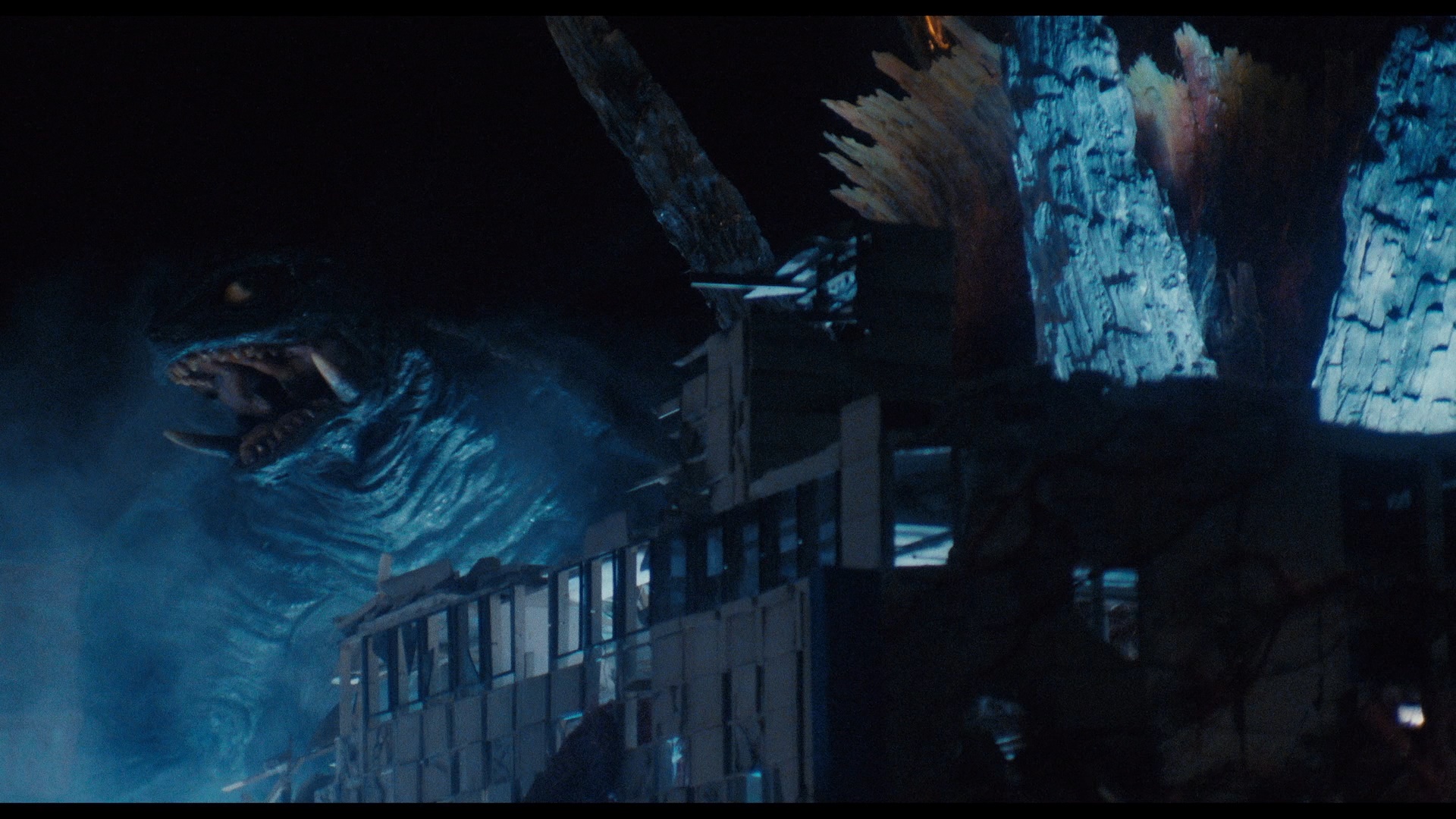 day at Tokyo's Hibiya Theater (2m55s), the U.S. and U.K. end credits, two teasers, the Japanese trailer, TV spots, the U.S. video trailer, a "Gyaos Destruction Strategy" SNES commercial, and a small image
day at Tokyo's Hibiya Theater (2m55s), the U.S. and U.K. end credits, two teasers, the Japanese trailer, TV spots, the U.S. video trailer, a "Gyaos Destruction Strategy" SNES commercial, and a small image 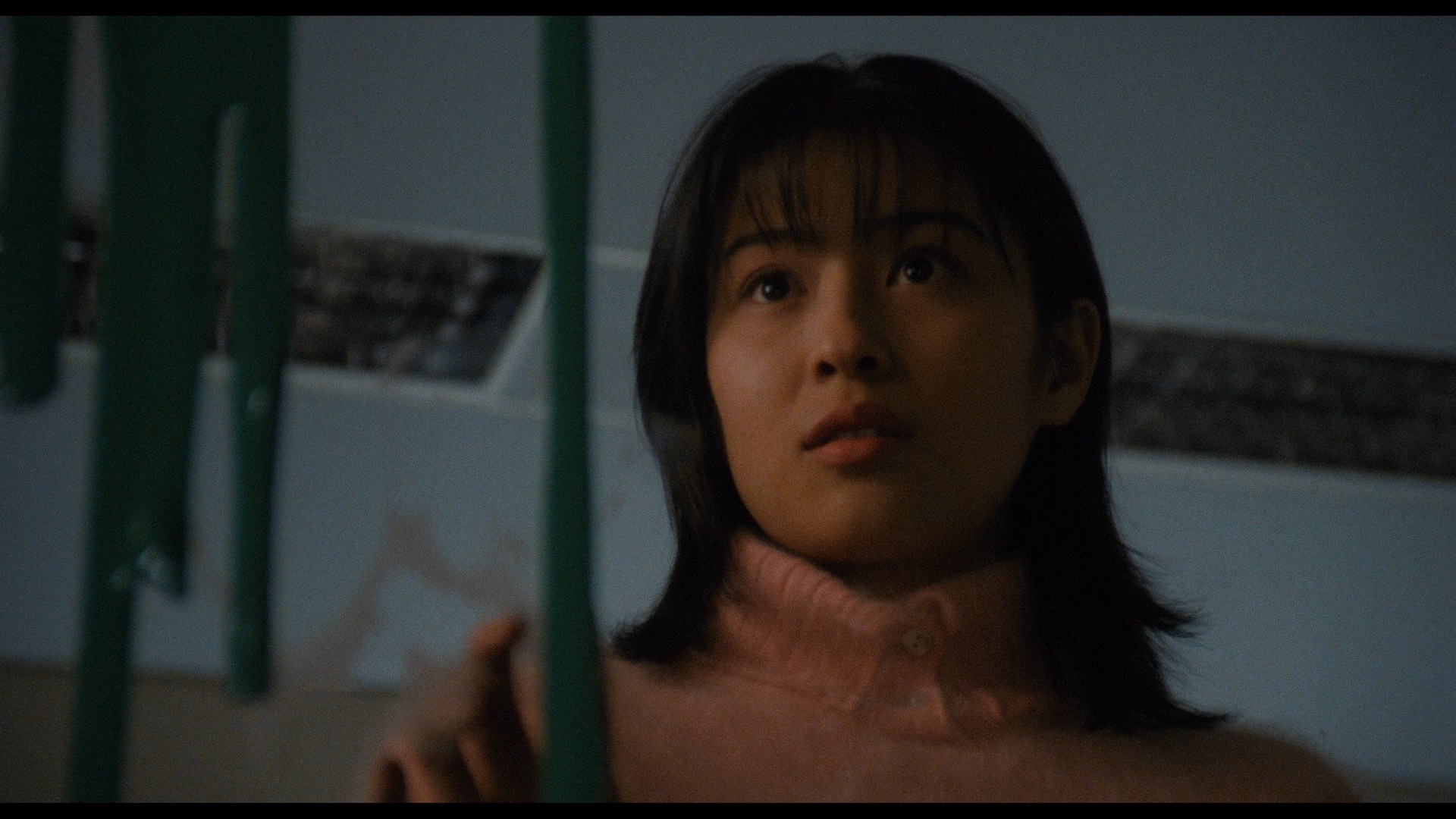 gallery (1m34s).
gallery (1m34s).
What is now known as the Hansei Trilogy continued quickly with the second installment, Gamera 2: Attack of Legion, which ups the ante in terms of both effects and monster action. This time a meteorite smacks into Japan and unleashes a swan of little aliens who, as the title implies, operate together as a kind of hive mind. Asagi is on hand again to communicate with Gamera for help as a science class who witnessed the landing becomes integral to getting clues to the evil plan that could imperil the planet.
As entertaining as the prior film, Legion again tries to make its obligatory human story more interesting than the standard fare with military and scientific 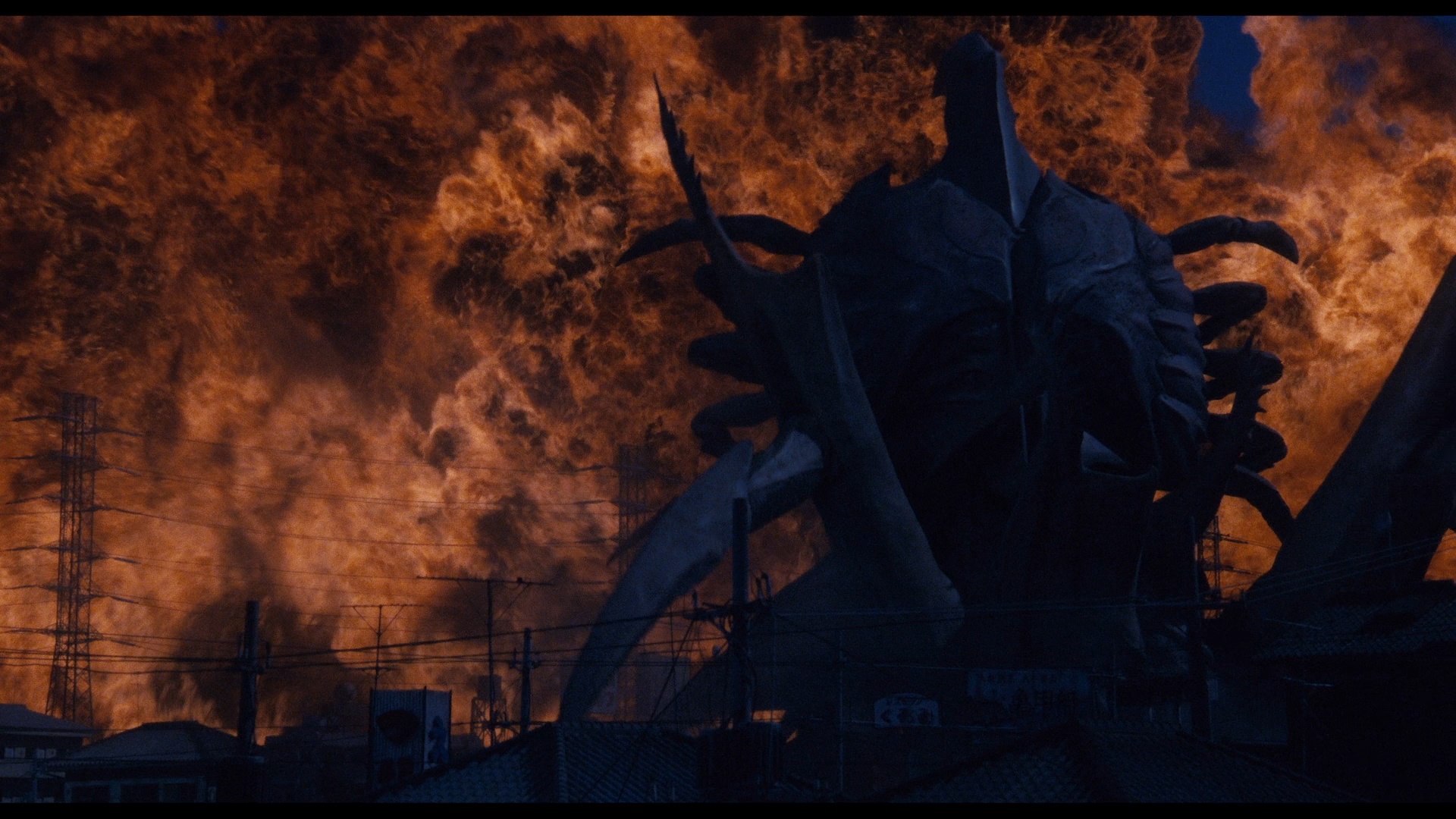 talking hands wondering what's going on; that mostly succeeds here, though of course the main attraction is the giant monster sequences which include a protracted, impressive climax that really knocked 'em dead on the big screen. Again the action is quite a bit more unsettling and violent than the classic films including a nasty first encounter that has the swarm tearing at our giant hero in a way that would've never flown on
talking hands wondering what's going on; that mostly succeeds here, though of course the main attraction is the giant monster sequences which include a protracted, impressive climax that really knocked 'em dead on the big screen. Again the action is quite a bit more unsettling and violent than the classic films including a nasty first encounter that has the swarm tearing at our giant hero in a way that would've never flown on 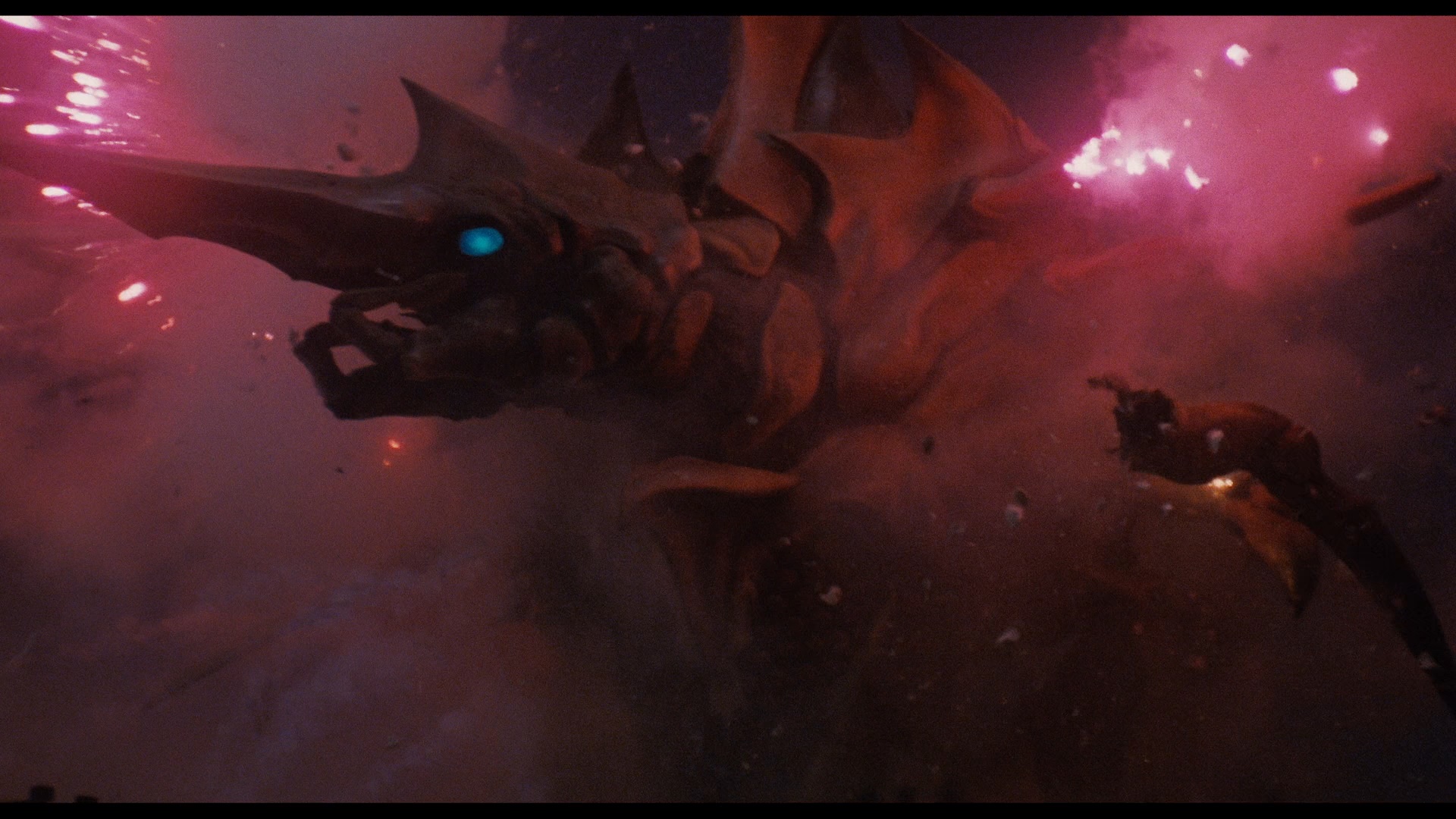 TV back in the '70s. Again the Arrow disc looks great and is more carefully encoded than the prior Mill Creek Blu-ray, while audio options include Japanese 5.1 and 2.0 and English 5.1 and 2.0 audio options, all guaranteed to test your speakers to the limit. You also get an audio commentary by Kyle Yount covering the film's place in the trilogy and its use of kaiju elements, and if you're so inclined, there's a "Lake Texarkana" comedy dub that... well, approach at your own risk. Video extras include a Ragone intro (4m21s), the second part of "A Testimony of 15 Years" (121m45s), behind-the-scenes footage (59m54s), special effects production footage (39m46s) including some really great coverage of the suits being created and rehearsed, the Daiei production announcement in 1995 (6m34s), a "Sky" backstage clip/music video (3m11s), a reel of promotional events coverage (5m16s), opening day at Hibiya Theater (3m58s), additional English credits, comedy dub outtakes, a behind the scenes trailer,
TV back in the '70s. Again the Arrow disc looks great and is more carefully encoded than the prior Mill Creek Blu-ray, while audio options include Japanese 5.1 and 2.0 and English 5.1 and 2.0 audio options, all guaranteed to test your speakers to the limit. You also get an audio commentary by Kyle Yount covering the film's place in the trilogy and its use of kaiju elements, and if you're so inclined, there's a "Lake Texarkana" comedy dub that... well, approach at your own risk. Video extras include a Ragone intro (4m21s), the second part of "A Testimony of 15 Years" (121m45s), behind-the-scenes footage (59m54s), special effects production footage (39m46s) including some really great coverage of the suits being created and rehearsed, the Daiei production announcement in 1995 (6m34s), a "Sky" backstage clip/music video (3m11s), a reel of promotional events coverage (5m16s), opening day at Hibiya Theater (3m58s), additional English credits, comedy dub outtakes, a behind the scenes trailer, 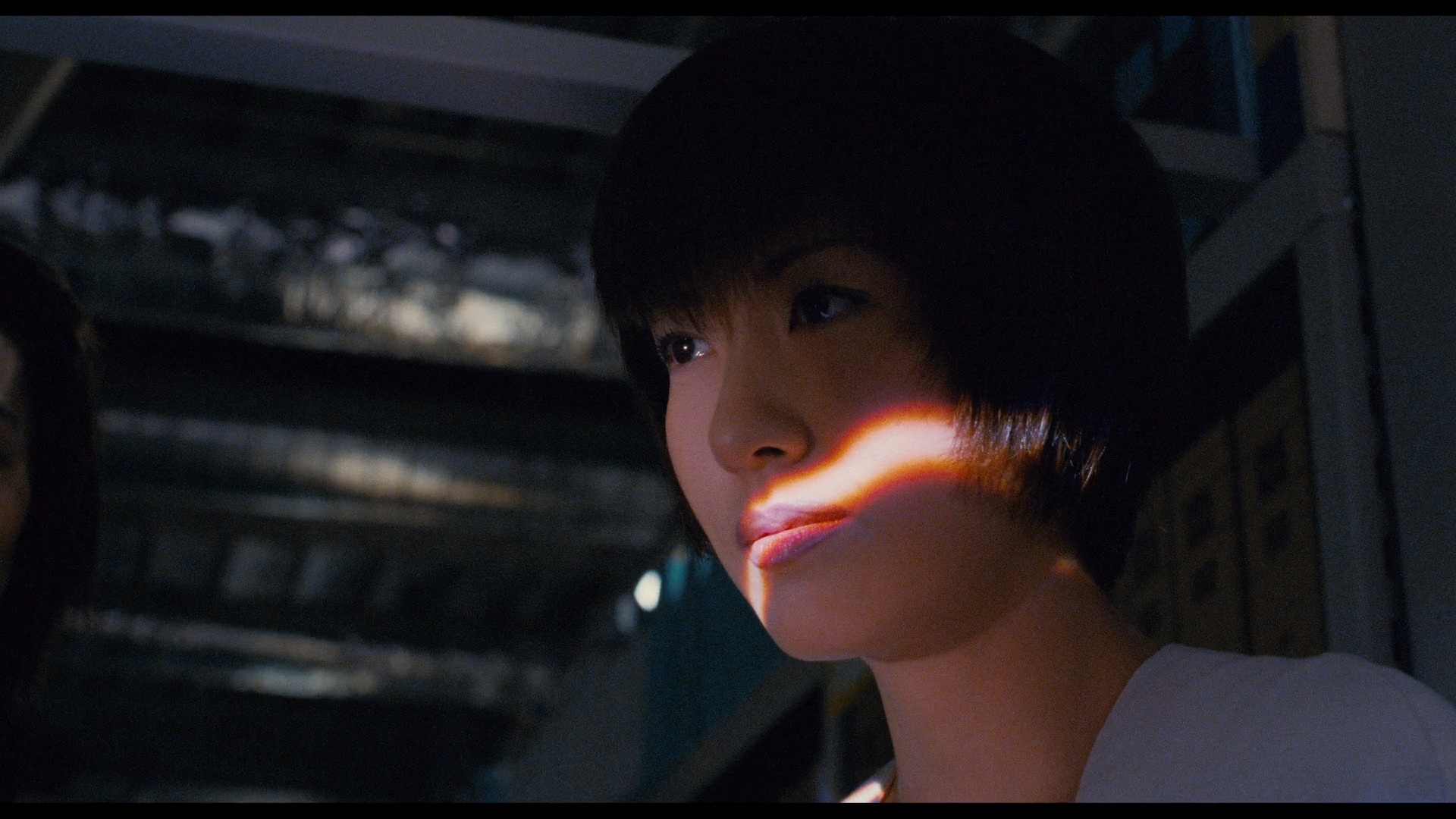 two"special" trailers, five theatrical trailers, TV spots, the U.S. video trailer, and an image gallery (2m3s).
two"special" trailers, five theatrical trailers, TV spots, the U.S. video trailer, and an image gallery (2m3s).
Three years later, the trilogy came to an end on a high note with Gamera 3: Revenge of Iris, which takes an intriguing angle by focusing on a revenge story based on previous events in the series. Here young Ayana (Maeda) blames Gamera for the death of her parents during one of the 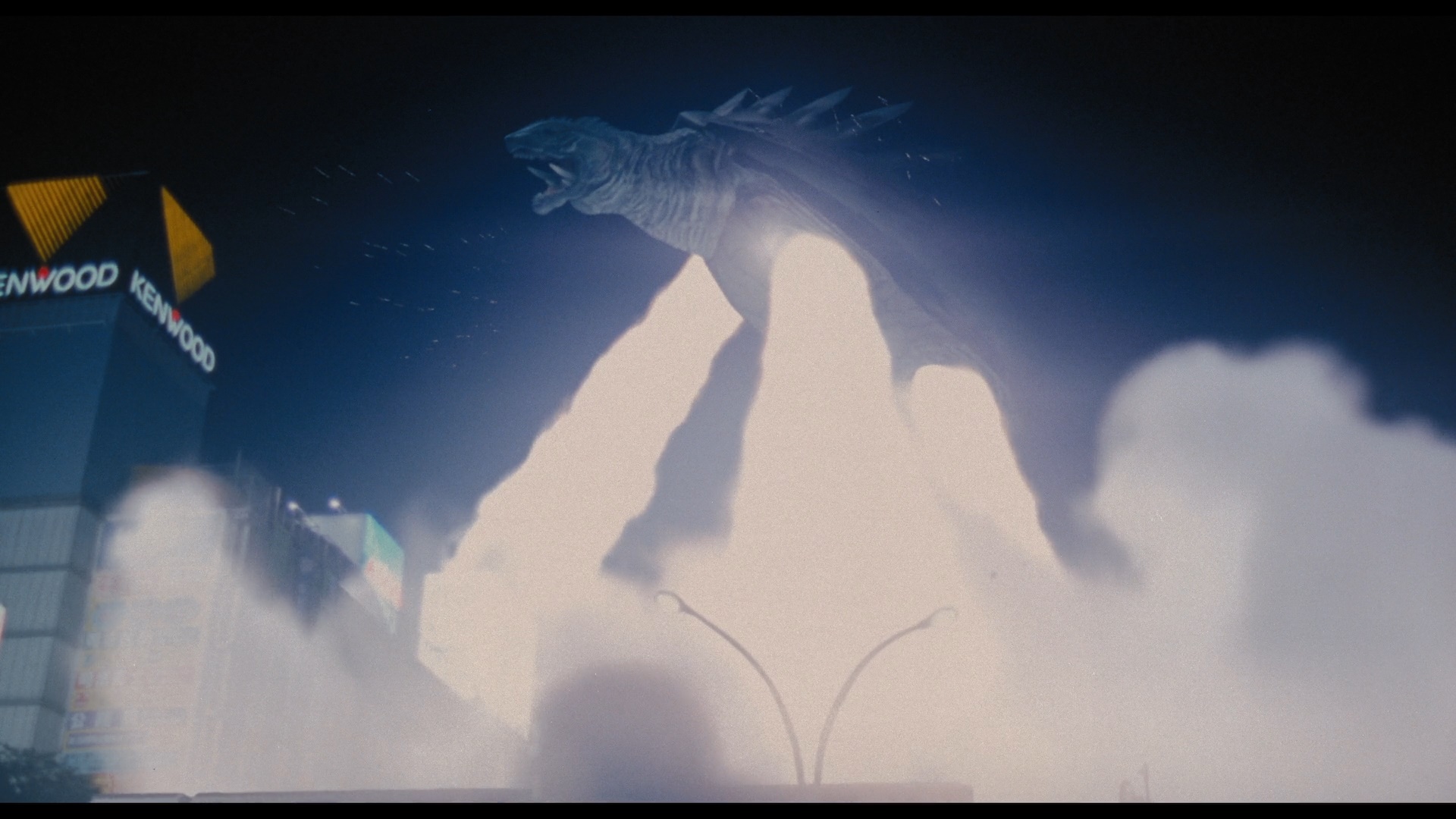 massive urban destruction rallies, which becomes focused when she finds an egg that contains the titular Iris, a monster with whom she shares a very dark mental bond. You also get a fun Gyaos return appearance here as well as some of the most intense kaiju sequences to date including a nighttime Kyoto Station assault that can still make jaws drop.
massive urban destruction rallies, which becomes focused when she finds an egg that contains the titular Iris, a monster with whom she shares a very dark mental bond. You also get a fun Gyaos return appearance here as well as some of the most intense kaiju sequences to date including a nighttime Kyoto Station assault that can still make jaws drop.
As with the prior two films, this one gets a Blu-ray to itself here in the Arrow set (versus the Mill Creek one that squished parts two and three together on one) and looks and sounds great throughout with the usual 5.1 and 2.0 Japanese and English options. Here you get an audio commentary by kaiju enthusiasts Steve Ryfle and Ed Godziszewski covering this darkest and most ambiguous entry of the three, a highly questionable "tongue-in-cheek" commentary by "Gamera, Iris & Soldier 6"
from the 2003 DVD. Video-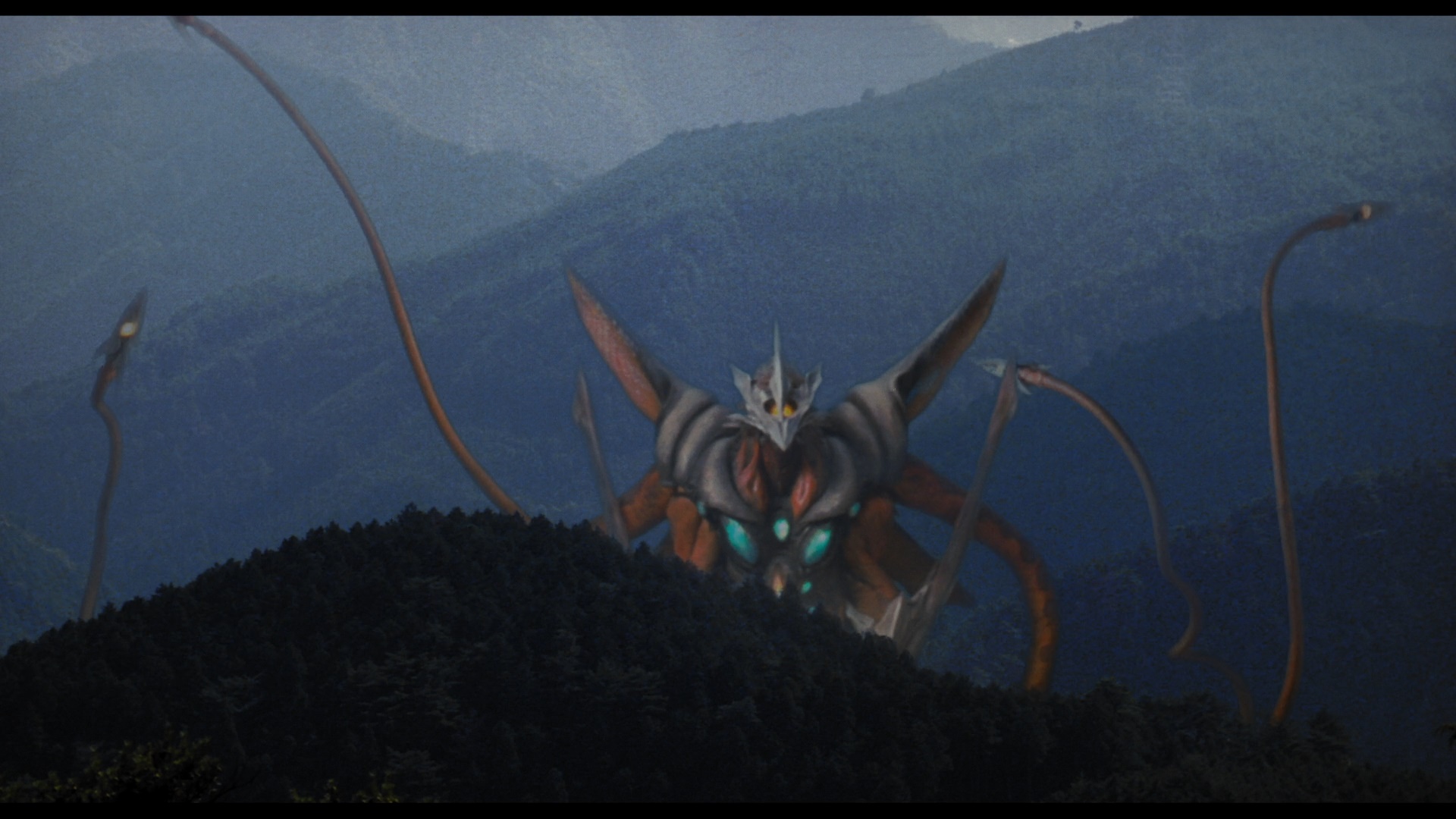 wise the disc includes a Ragone intro (4m14s), "A Testimony of 15 Years: Part 3" (134m31s), a new Kaho Tsutsumi interview (10m47s) from the DNA Tokusatsu exhibition in Tokyo with historian Edward L. Holland speaking with the press and publicity coordinator, a publicity announcement (3m50s), photo op footage (55s), an "I Want You to Teach Me Again" backstage clip/music video (4m41s), opening day footage (6m) from Shibuto Cine
wise the disc includes a Ragone intro (4m14s), "A Testimony of 15 Years: Part 3" (134m31s), a new Kaho Tsutsumi interview (10m47s) from the DNA Tokusatsu exhibition in Tokyo with historian Edward L. Holland speaking with the press and publicity coordinator, a publicity announcement (3m50s), photo op footage (55s), an "I Want You to Teach Me Again" backstage clip/music video (4m41s), opening day footage (6m) from Shibuto Cine 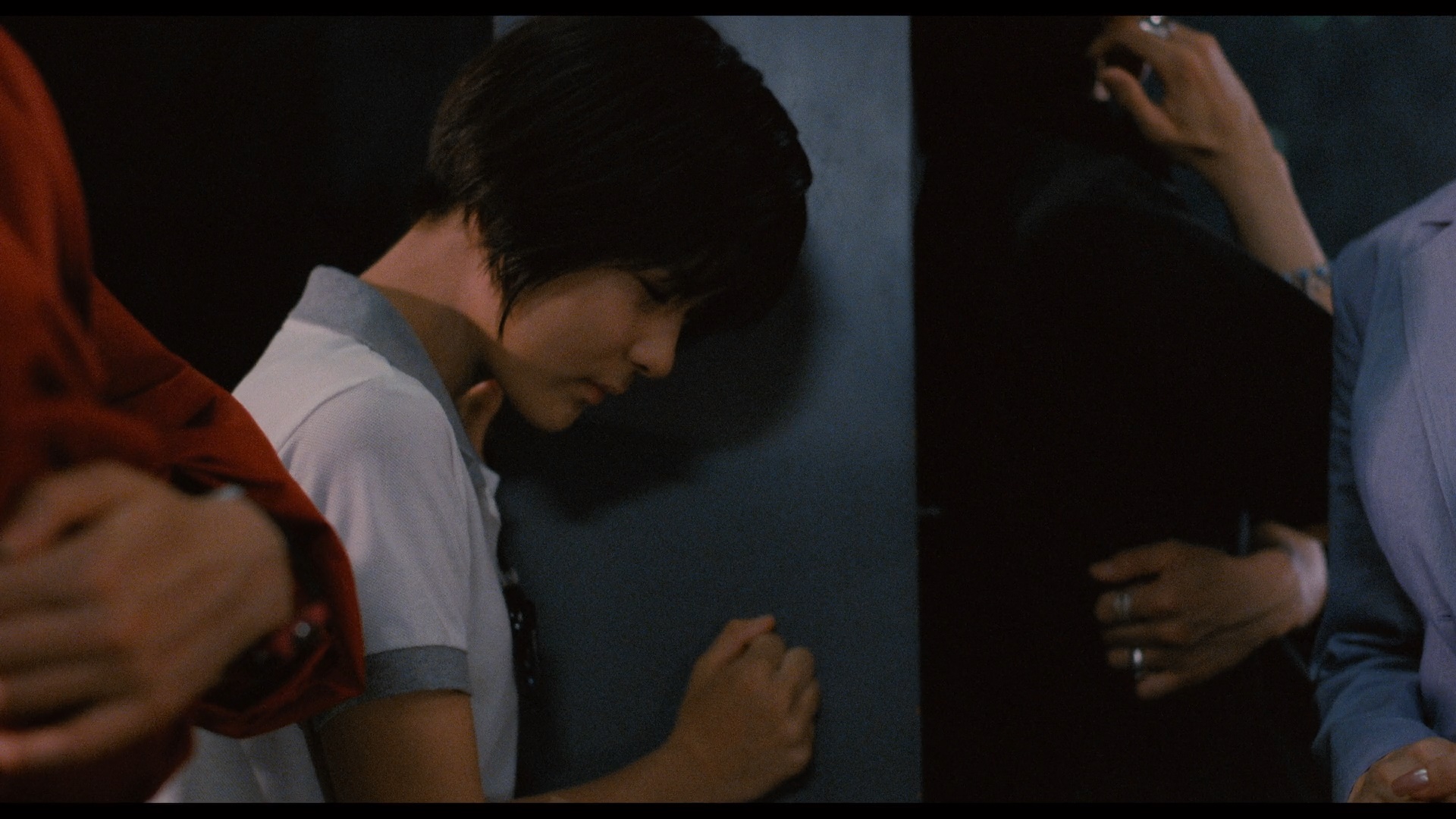 Tower, a reel of deleted scenes (10m21s), an "Awakening of Irys" production and effects footage montage (37m34s), storyboard animations (6m8s), special effects outtakes (2m19s), some really terrible comedy dub outtakes (3m24s), additional English credits, five trailers, TV spots, a U.S. video trailer, a Gamera 2000 Playstation commercial, and an image gallery (19m21s).
Tower, a reel of deleted scenes (10m21s), an "Awakening of Irys" production and effects footage montage (37m34s), storyboard animations (6m8s), special effects outtakes (2m19s), some really terrible comedy dub outtakes (3m24s), additional English credits, five trailers, TV spots, a U.S. video trailer, a Gamera 2000 Playstation commercial, and an image gallery (19m21s).
Finally we reach the last outing for the colossal turtle to date, Gamera the Brave, which is more of a throwback to the '70s era in many respects (especially going back to shooting in scope and featuring a more traditional child protagonist). The tone is sunnier and more benign as well (though not free of violence) as the story attempts a reboot of sorts with Gamera missing in action since 1973 after a fatal Gyaos encounter. In the present day, young Toru (Tomioka) finds an egg that hatches into a baby turtle who grows very quickly and displays an ability to 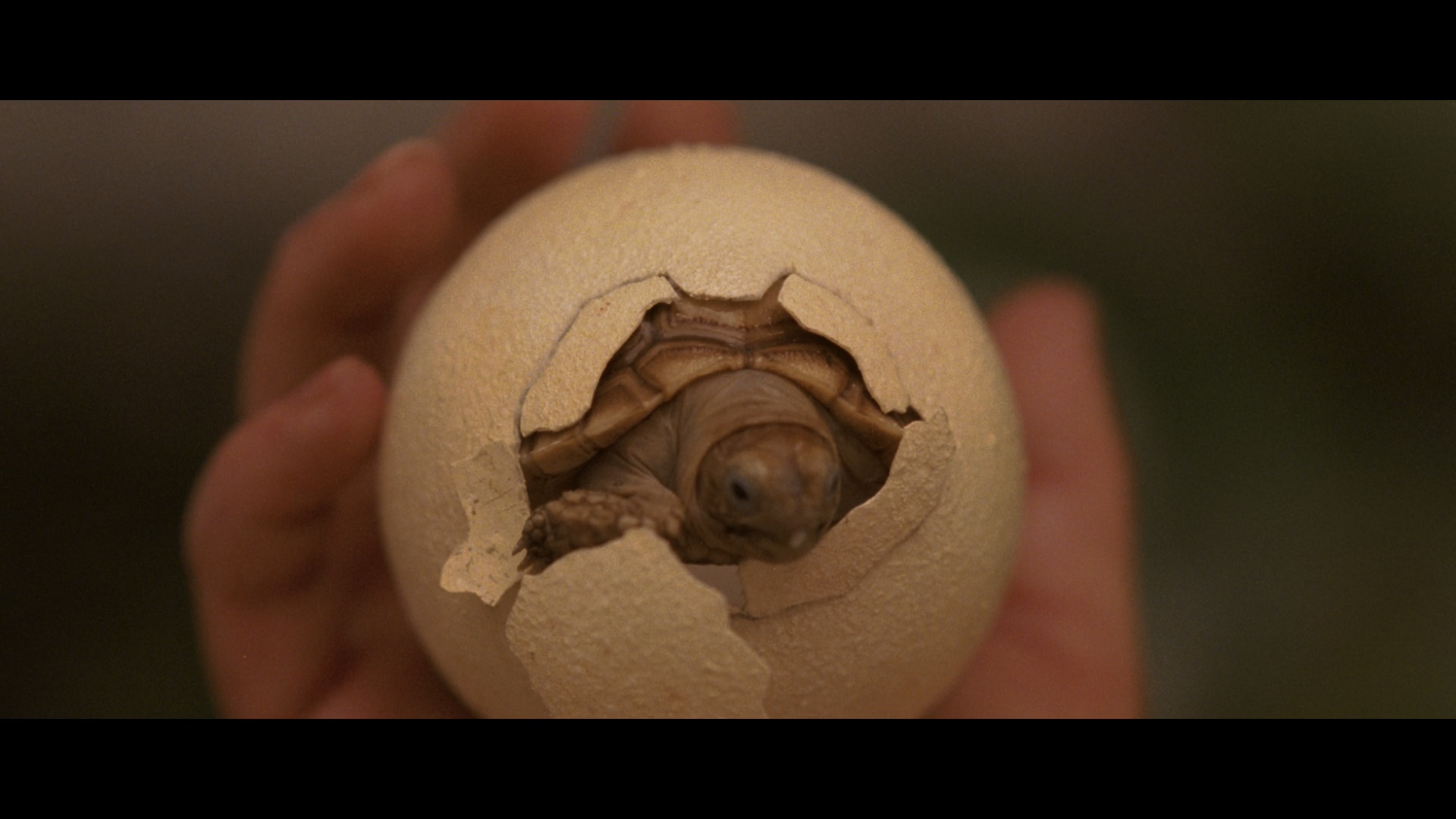 breathe fire. As Toru and his friends try to keep the discovery under wraps, the young Gamera quickly outgrows his habitat and becomes involved in a conflict with a new monster foe, Zedus, with both their fates tied to some mystical red stones.
breathe fire. As Toru and his friends try to keep the discovery under wraps, the young Gamera quickly outgrows his habitat and becomes involved in a conflict with a new monster foe, Zedus, with both their fates tied to some mystical red stones.
The stark contrast between this film and its immediate three predecessors should be obvious to even the most casual viewer with the new 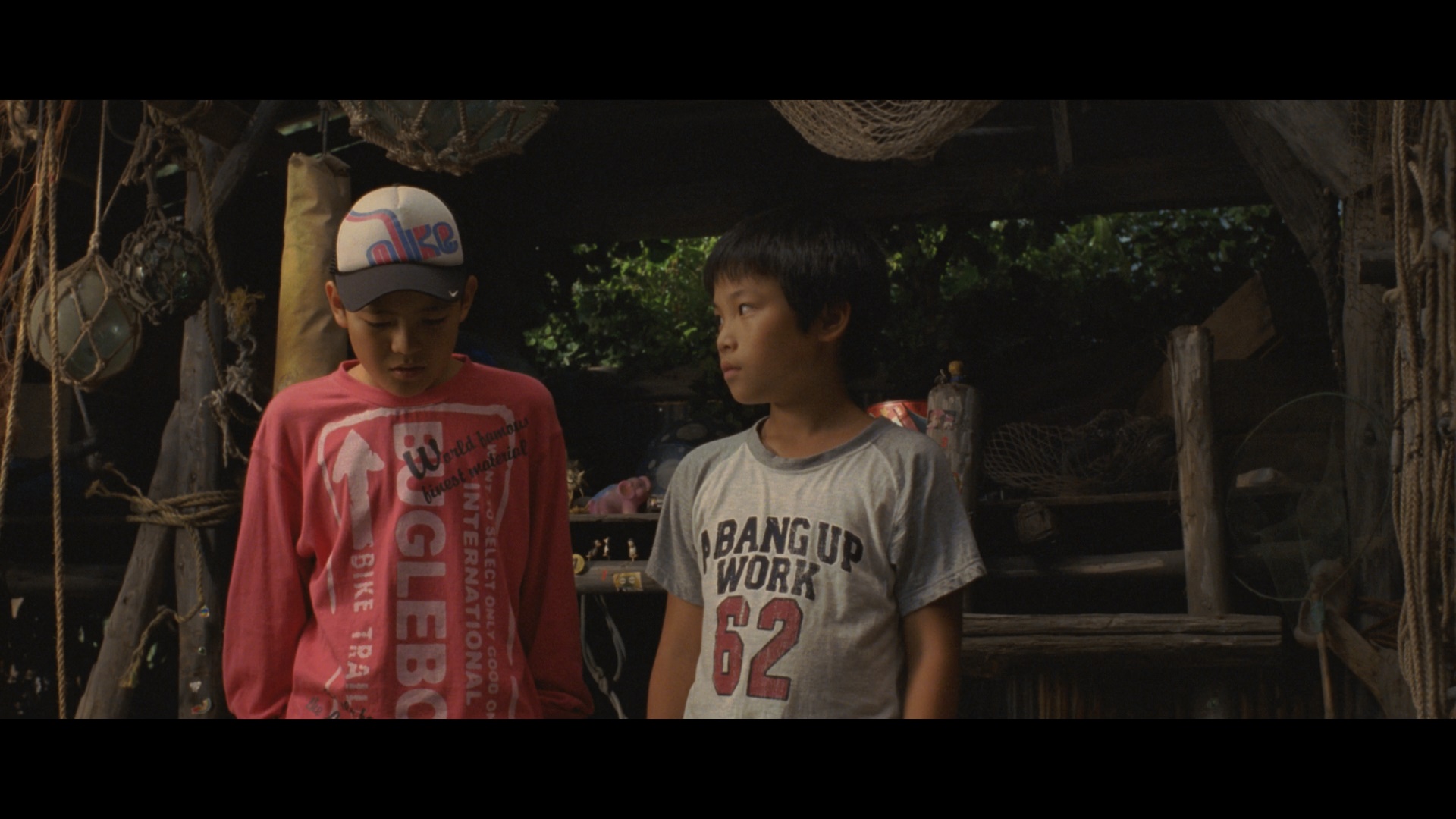 leadership at Daiei going for a more family-friendly vibe, but on those terms it's perfectly entertaining and now functional as a kind of agreeable chaser after stampeding through all the other Gamera films in this set. The effects are solid as you'd expect with our shelled protagonist getting a softer, more toy-friendly makeover here that suits the sunnier look of the film itself. This one has always looked good on home video, and the Arrow disc is no exception with its golden hues and spacious framing making for quite a treat for the eyes. Again you get Japanese 5.1 and 2.0 plus English 5.1 and 2.0 audio options with English subs, with Keith Aiken and Bob Johnson providing a studied audio commentary contextualizing this one within the series including its attempt to appeal to a younger audience. Other extras include the archival "How to Make a Gamera Movie" featurette (37m15s) with director Ryota Tasaki, a behind-the-scenes documentary (63m39s) with cast interviews and production footage, "The Men That Made Gamera" featurette (43m16s) surveying the entire series, footage from the first public screening at Marunouchi Piccadilly in Tokyo in 2006 (5m1s), a "Kaho's Summer"
leadership at Daiei going for a more family-friendly vibe, but on those terms it's perfectly entertaining and now functional as a kind of agreeable chaser after stampeding through all the other Gamera films in this set. The effects are solid as you'd expect with our shelled protagonist getting a softer, more toy-friendly makeover here that suits the sunnier look of the film itself. This one has always looked good on home video, and the Arrow disc is no exception with its golden hues and spacious framing making for quite a treat for the eyes. Again you get Japanese 5.1 and 2.0 plus English 5.1 and 2.0 audio options with English subs, with Keith Aiken and Bob Johnson providing a studied audio commentary contextualizing this one within the series including its attempt to appeal to a younger audience. Other extras include the archival "How to Make a Gamera Movie" featurette (37m15s) with director Ryota Tasaki, a behind-the-scenes documentary (63m39s) with cast interviews and production footage, "The Men That Made Gamera" featurette (43m16s) surveying the entire series, footage from the first public screening at Marunouchi Piccadilly in Tokyo in 2006 (5m1s), a "Kaho's Summer" 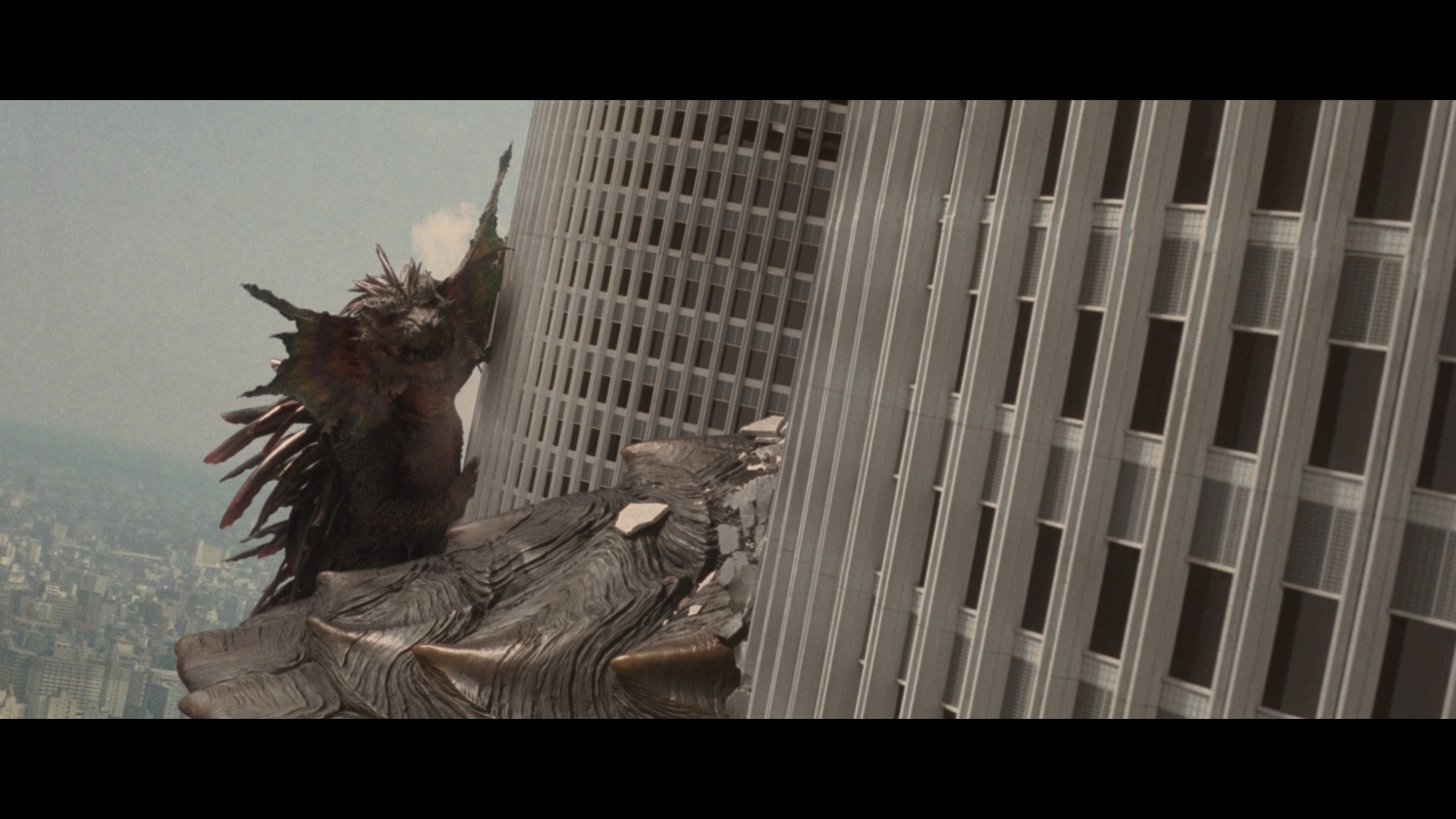 interview (10m1s) with the young star on the set, a special effects supercut (32m32s) assembled by FX supervisor Hajime Matsumoto,
two teasers, the Japanese trailer, two TV spots, and an image gallery (14m50s). Of course, one of the real stars of this set is the gorgeous (and heavy!)
interview (10m1s) with the young star on the set, a special effects supercut (32m32s) assembled by FX supervisor Hajime Matsumoto,
two teasers, the Japanese trailer, two TV spots, and an image gallery (14m50s). Of course, one of the real stars of this set is the gorgeous (and heavy!)  packaging itself; Arrow was clearly gunning to outdo Criterion's deluxe Godzilla set from 2019, and they pull it off here with a set that will look magnificent on your shelf. The discs are housed in a sturdy book design with extensive striking illustrations and, at the back, a series of illustration cards representing each film; there's also a separate book containing featuring notes on each film by Patrick Macias, an interview with Yuasa by David Milner, some nifty kaiju X-ray drawings by Jolyon Yates, Fangoria set reports on the Heisei trilogy by Norman England, and a viewers' guide to the English dubs. Tucked away behind the cover is a double-sided, four-panel poster of "Gamera's Map of Japan" in Japanese and English. There's also a hardback 130-page book featuring the full comic book four-issue Gamera run from Dark Horse Comics from 1996 and the English-langauge debut of the prequel comic, Matt Frank and Joshua Bugosh's The Last Hope.
packaging itself; Arrow was clearly gunning to outdo Criterion's deluxe Godzilla set from 2019, and they pull it off here with a set that will look magnificent on your shelf. The discs are housed in a sturdy book design with extensive striking illustrations and, at the back, a series of illustration cards representing each film; there's also a separate book containing featuring notes on each film by Patrick Macias, an interview with Yuasa by David Milner, some nifty kaiju X-ray drawings by Jolyon Yates, Fangoria set reports on the Heisei trilogy by Norman England, and a viewers' guide to the English dubs. Tucked away behind the cover is a double-sided, four-panel poster of "Gamera's Map of Japan" in Japanese and English. There's also a hardback 130-page book featuring the full comic book four-issue Gamera run from Dark Horse Comics from 1996 and the English-langauge debut of the prequel comic, Matt Frank and Joshua Bugosh's The Last Hope.
Reviewed on August 23, 2020
![]()